Benny Lewis's Blog, page 7
March 11, 2024
50+ Ways to Say “I Love You” in French
Je t’aime is how you say “I love you” in French, but there’s a common mistake many learners make. Adding a little bien or beaucoup at the end of je t’aime actually makes the meaning less strong. So je t’aime is “I love you,” and je t’aime bien is “I like you.”

We’re going to go into a lot more depth on saying “I love you” in French, but first a little bit about me, your French-speaking guide.
I studied French at university and lived in French-speaking countries for two years. It’s a pretty amazing language to learn! Once you look away from details like French grammar and focus on the fun stuff, French gets better and better.
And you know what? When you’re having fun with the language, you tend to speak it better, too.
We’ll look at a fun topic today: saying “I love you” in French. Often referred to as a romantic language, French definitely has a lot of different ways of expressing love.
Allez! Let’s go!
function runSplitTest(){var randomNumber = Math.floor(Math.random() * 2) + 1console.log(randomNumber)var copy = "";if (randomNumber == 3){ copy = '<i>A note from the Fluent in 3 Months team before we get started: You can chat away in French for at least 15 minutes with the "Fluent in 3 Months" method. All it takes is 90 days. <b><a href="https://fluentin3months.com/challenge... this link to find out more.</b></a></i>'} else { copy = '<i>Editor's note: Before we get started, if you’re looking for an online French course, here’s the course we recommend: <a href="https://www.fluentin3months.com/olly-... Uncovered - Learn French Through the Power of Story</b></a>, a course with a fascinating new method by Olly Richards. You can try it for free for 7 days!</i>'}console.log(copy)var copyToChange = document.querySelector("p.copyText").innerHTML = copy;}runSplitTest();Table of contents3 Good Reasons to Learn How to Say “I Love You” in FrenchHow to Say “I Love You” in French: Master the BasicsEnhance Your I Love You With French Endearment Terms50 More Ways to Say “I Love You” in FrenchShow Your Love in French3 Good Reasons to Learn How to Say “I Love You” in French“I love you” is the start of many other related phrases and verbs you’ll learn, such as aimer (“to love”), adorer (“to adore”), chérir (“to cherish”) and more. This magic phrase will not only broaden your vocabulary but it will also help you get closer to French culture.
Here are three good reasons why you should learn je t’aime and love-related words:
Show appreciation to your loved ones. Many people learn a new language to speak to their partner or family. If you have a French-speaking loved one, saying “I love you” in French can deepen the relationship. Plus, with the other creative versions of je t’aime we’ll cover in this article, you can be sure to impress your partner!
Watch romantic French films. There are so many French films about love. Amélie, for example, is a critically acclaimed French film about a young woman living in Paris who helps those around her and ends up finding love.
Listen to romantic French songs. Similar to films, French songs often talk about deep romantic feelings. Take Lara Fabian’s song Je t’aime, as an example. Even for non-French speakers, the song is very moving. Imagine how it would be if you understood the lyrics. Sneak peek: in the chorus, she says je t’aime comme un fou, comme un soldat, meaning “I love you, like a fool, like a soldier.”
How to Say “I Love You” in French: Master the Basics“I love you” in French is je t’aime. It’s quite simple to translate:
Je means “I.”T is actually te, meaning “you.” It’s written as t’ because the next word (aime) starts with a vowel.Aime comes from the French verb aimer, which means to love.
You can use je t’aime for your partner, family, or friends. But here’s where it gets tricky: je t’aime is an intense type of love. If you’re saying je t’aime to a romantic interest, you’re not simply showing affection, you’re telling that you’re in love with them.
If you want to step down a bit, go for je t’aime bien, which means “I like you.”
Right between je t’aime and je t’aime bien stands je t’aime beaucoup, meaning “I like you a lot.” Then there’s je t’adore, which we can describe as “I really, really like you.”
For starters, just remember that je t’aime is the most powerful way to say “I love you.” If you add a bien or a beaucoup in the end, it weakens the meaning.
Enhance Your I Love You With French Endearment TermsUse these French endearment terms to complement your je t’aime:
Mon amour: “My love”Mon chéri/ Ma chérie: “My dear/my beloved” (If you’re speaking to a man, you say mon chéri. If you’re speaking to a woman, you say ma chérie.)Mon ange: “My angel”Mon trésor: “My treasure”Ma douce: “My sweet”Ma moitié: “My other half”Mon cœur: “My heart” 50 More Ways to Say “I Love You” in French
50 More Ways to Say “I Love You” in FrenchDon’t just stick to je t’aime — get creative! French is definitely the right language for that. Here are 50 ways to say “I love you” in French:
Je t’aime: “I love you.” Worth noting again, je t’aime in French is “I love you” in an intense way.Je t’aime bien: “I like you.”Je t’adore: “I adore you.” A step above “I like you” and just below “I love you,” it’s perfect for those strong but not quite yet full-blown romantic feelings.Je te kiffe: “I really like you.” Last but not least, here’s another way of saying I like you. This one’s informal and slang, especially popular among young people.Je suis amoureux/amoureuse de toi: “I am in love with you.” If you’re male, you say amoureux, if you’re female, you say amoureuse.Je t’aime très fort: “I love you so much.”Tu es l’amour de ma vie: “You are the love of my life.”Je t’aime de tout mon cœur: “I love you with all my heart.”Je t’aime à la folie: “I love you madly.”Je t’aime plus qu’hier moins que demain: “I love you more than yesterday but less than tomorrow.” Taken from a poem by French poet Rosemonde Gérard, this sentence alone paints a picture of why French is known as a romantic language.Mon amour pour toi est éternel: “My love for you is eternal.”Je t’aime pour toujours: “I love you forever.”Mon cœur est à toi: “My heart is yours.”Tu es mon âme sœur: “You are my soulmate.” The French word for “soulmate” is âme sœur, literally meaning “soul sister.”Je suis fou/folle de toi: “I am crazy about you.” If you’re a man, you say fou, if you’re a woman, you say folle.Je suis dingue de toi: “I am crazy about you.” Similar to je suis fou/folle de toi.Tu es ma raison de vivre: “You are my reason to live.”Je t’aime infiniment: “I love you infinitely.”Je ne peux pas vivre sans toi: “I can’t live without you.”Tu es la meilleure chose qui me soit arrivée: “You are the best thing that has happened to me.”Je t’aime plus que tout au monde: “I love you more than anything in the world.”Tu es mon trésor: “You are my treasure.”Je t’aimerai toujours: “I will always love you.”Tu me rends heureux/heureuse: “You make me happy” (male/female).Tu me manques: “I miss you.” Although it means “I miss you,” this sentence literally translates as “you are missing from me.”Tu es parfait(e) comme tu es: “You are perfect the way you are.”Je suis tombé(e) amoureux/amoureuse de toi: “I’ve fallen in love with you” (male/female).Tu es le meilleur/la meilleure: “You are the best” (male/female).Je t’aime profondément: “I deeply love you.”Je suis à toi: “I am yours.”Ton amour est le cadeau le plus précieux: “Your love is the most precious gift.”Tu es ma personne préférée: “You’re my favourite person.”J’adore passer du temps avec toi: “I love spending time with you.”Je veux faire ma vie avec toi: “I want to spend my life with you.”Tu me complètes: “You complete me.”Je t’aime chaque jour davantage: “I love you more each day.”Mon cœur bat pour toi: “My heart beats for you.”Tu es mon soleil: “You are my sunshine.” (Literal translation: You are my sun.)Tu es mon soleil dans la nuit: “You are my sun in the dark.”Je te chéris: “I cherish you.”Avec toi, je suis complet/complète: “With you, I am complete” (male/female).Tu me rends fou/folle: “You drive me crazy” (male/female).Tu es l’unique pour moi: “You are the only one for me.”Toi et moi, c’est pour la vie: “You and me, it’s for life.”Mon amour envers toi est incommensurable: “My love for you is immeasurable.”Je veux vieillir avec toi: “I want to grow old with you.”Tu es la lumière de ma vie: “You are the light of my life.”Tu es tout pour moi: “You are everything to me.”Tu es ma moitié: “You are my other half.”Tu illumines ma vie: “You light up my life.”Show Your Love in FrenchNow that you know how to say “I love you” in French, it’s time to put it into practice. Say je t’aime plus que tout to your partner, try recognizing the words in Lara Fabian’s song Je t’aime, or watch a romantic film to immerse yourself in French love.
How to Say “My Love” in French (Plus 28 More Romantic French Words and Phrases)How to Speak French: The Faster Way to Learn French70 Terms of Endearment from Around the World (for Those You Love)How to Say “I Love You” in Spanish (and 50+ Other Romantic Phrases)The post 50+ Ways to Say “I Love You” in French appeared first on Fluent in 3 Months.
March 8, 2024
20 German Tongue Twisters to Help You Master Speaking German
There are so many tools and language hacks to help you learn German quickly and with ease. One of these is to master pronunciation with German tongue twisters.
You can find German tongue twisters or deutsche Zungenbrecher in different forms and German dialects. All you need to start practicing are the sounds, words and letters giving you trouble.
function runSplitTest(){var randomNumber = Math.floor(Math.random() * 2) + 1console.log(randomNumber)var copy = "";//csakamasodikif (randomNumber == 3){ copy = '<i>A note from the Fluent in 3 Months team before we get started: You can chat away in German for at least 15 minutes with the "Fluent in 3 Months" method. All it takes is 90 days. <b><a href="https://fluentin3months.com/challenge... this link to find out more.</b></a></i>'} else { copy = '<i>Before we get started, if you’re looking for an online German course, here’s the course I recommend: <a href="https://www.fluentin3months.com/olly-... Uncovered - Learn German Through the Power of Story</b></a>, a course with a fascinating new method by my friend Olly. You can try it for free for 7 days!</i>'}console.log(copy)var copyToChange = document.querySelector("p.copyText").innerHTML = copy;}runSplitTest();Table of contentsWhy Study German Tongue TwistersMost Popular German Tongue Twisters1 – Blaukraut bleibt Blaukraut und Brautkleid bleibt Brautkleid.2 – Fischers Fritze fischt frische Fische.3 – Schnecken erschrecken, wenn sie an Schnecken schlecken, weil zum Schrecken vieler Schnecken Schnecken nicht schmecken.4 – Am zehnten Zehnten, zehn Uhr zehn zogen zehn zahme Ziegen zehn Zentner Zucker zum Zoo.German Tongue Twisters for Umlauts, R and CH5 – Die ältere Schwester kam im März spät mit einem Käsekorb nach Hause und fand in der Nähe einen Bären.6 – Die zwölf österreichischen Vögel versteckten den schönen Löffel des Königs in Kölns höchstem Baum.7 – Herr Lücke ging über eine Brücke, sah eine Mücke und nahm seine Krücke, um sie zu schlagen.8 – Rasent rasantes Rumpelstilzchen ruppelt Rolos rauf und runter.9 – Aldrichs Tochter besuchte gern die Kirche am Bach und las Bücher.Easy German Tongue Twisters10 – Violett steht ihr recht nett, recht nett steht ihr violett.11 – Kleine Kinder können keine Kirschkerne knacken.12 – Der Mondschein schien schon schön.Hard German Tongue Twisters13 – Ein Dutzend nuschelnde Dutzer dutzen nuschelnd dutzende dutzender Nuschler nuschelnd.14 – Klitzekleine Katzen kotzen klitzekleine Kotze. Klitzekleine Kotze kotzen klitzekleine Katzen.15 – Sie stellte das Tschechische Streichholzschächtelchen auf den Tisch, auf den Tisch stellte sie das Tschechische Streichholzschächtelchen.German Tongue Twisters for Different Dialects16 – Z Schwyz am Ziit schiind d Sunne, und schiind si nid z Schwyz, so schiind si z Brunne.17 – Vena laus amoris, pax, druxun goris.18 – S´Vuchtlond is do wo de Hasn Hosn un de Hosn Husn haßen.19 – Zwischen zwa Zwetschgenzweigerln sitzen zwei Zeiserln.20 – Moischt, mascht Moscht? Moscht muasch ma mega!Why Study German Tongue TwistersOne of the first steps to learning a new language is hearing and voicing the new sounds of your target language. In German, English-speakers usually find ä, ü, ö, r, and ch to be difficult. When you begin learning German, you might doubt you’ll ever be able to make and combine these new sounds together without extra thought. But have no fear!
Therapists and educators use Deutsche Zungenbrecher, directly translated to “German tongue-breakers,” in classrooms and clinics to practice pronunciation.
Using themed tongue twisters, such as seasons or animals, can also help you build your vocabulary.
Last, using sound-specific tongue twisters can help train your ear and tongue to pronounce sounds that aren’t used in your native language.
Most Popular German Tongue TwistersIn both English and German, some tongue twisters are more known than others. In English, the most popular is “Peter Piper picked a peck of pickled peppers.” The German language also has its classic and widely known Zungenbrecher.
1 – Blaukraut bleibt Blaukraut und Brautkleid bleibt Brautkleid.“Blue cabbage remains blue cabbage, and a wedding dress remains a wedding dress.”
2 – Fischers Fritze fischt frische Fische.“Fisher’s pal fishes fresh fish.”
There is also a longer version – Fischers Fritz fischt frische Fische, frische Fische fischt Fischers Fritz.
3 – Schnecken erschrecken, wenn sie an Schnecken schlecken, weil zum Schrecken vieler Schnecken Schnecken nicht schmecken.“Snails are startled when they lick snails because snails don’t taste good to the horror of many snails.”
4 – Am zehnten Zehnten, zehn Uhr zehn zogen zehn zahme Ziegen zehn Zentner Zucker zum Zoo.“On the tenth Tenth, at 10:10, ten tame goats moved ten quintals of sugar to the zoo.”
German Tongue Twisters for Umlauts, R and CHThe English language doesn’t use umlauts – the dots above the German vowels a, o and u. The dots tell you to add an “eh” sound when you pronounce the normal vowel.
A + E = ÄO + E = ÖU + E = ÜThe English language rarely uses the hard “ch” sound as in the English word “loch” or the German word Bauch. English also doesn’t use the soft “ch” sound as in the Standard German words Kirche or Bücher. Last, English uses a different “r” sound.
For speakers of multiple languages, many German sounds may be already familiar to you, because one of your languages uses it too. All you have to do is transfer your sound knowledge from your language to your target language and then focus on any new sounds.
For example, it took me years to realize that the Welsh “LL” sound is similar to the High German soft “ch” sound. It’s not exactly the same, but even a little bit goes a long way. Low German dialects have mostly kept the hard “ch” for every word. In Chur, Switzerland, you’ll hear even the German word ich with the “ch” sounding similar to the “ch” in Bauch.
By using sound-specific German tongue twisters, you can target whichever sounds you find hard to pronounce and practice them to perfection. Below are tongue twisters that focus on sounds frequently difficult for English-speakers.
5 – Die ältere Schwester kam im März spät mit einem Käsekorb nach Hause und fand in der Nähe einen Bären.“The older sister came home late with a basket of cheese in March and found a bear closeby.”
6 – Die zwölf österreichischen Vögel versteckten den schönen Löffel des Königs in Kölns höchstem Baum.“The twelve Austrian birds hid the king’s beautiful spoon in Köln’s highest tree.”
7 – Herr Lücke ging über eine Brücke, sah eine Mücke und nahm seine Krücke, um sie zu schlagen.“Mr. Lücke went over a bridge, saw a mosquito and took his crutch to hit it.”
This is a shortened version of the long German tongue twister given below:
Herr und Frau Lücke gingen über eine Brücke. Da kam eine Mücke und stach Frau Lücke ins Genicke. Da nahm Herr Lücke seine Krücke und schlug Frau Lücke ins Genicke. Weswegen dann Frau Lücke mit der Mücke und der Krücke im Genicke tot umfiel.
“Mr. and Mrs. Lücke went over a bridge. Then, a mosquito came and stabbed Frau Lücke in the neck. Then, Mr. Lücke took his crutch and slapped Ms. Lücke in the neck. Which is why Ms. Lücke then, with the mosquito and the crutch in the neck, fell dead.”
8 – Rasent rasantes Rumpelstilzchen ruppelt Rolos rauf und runter.“Furios, fast Rumpelstitskin rumbled (Venetian) blinds up and down.”
Here das Rolo is a Venetian window blind that rolls up and down. It’s nowadays more commonly called die Jalousie.
9 – Aldrichs Tochter besuchte gern die Kirche am Bach und las Bücher.“Aldrich’s daughter liked to visit the church by the stream and read books.”
This one will let you practice switching between the two High German “ch” sounds.
Hard “ch” (as in the English word “loch”) – Aldrich, Tochter, Besuchte, BachSoft “ch” (as in the Welsh letter “LL”) – Kirche, BücherEasy German Tongue TwistersGerman and English share a lot of the same sounds thanks to their common heritage as Germanic languages. Find out why learning German is simple for English-speakers here. Easy German tongue twisters highlight this feature in simple, short sentences.
10 – Violett steht ihr recht nett, recht nett steht ihr violett.“Purple suits her quite nicely, quite nicely suits her purple.”
11 – Kleine Kinder können keine Kirschkerne knacken.“Small children can crack no cherry stones.”
12 – Der Mondschein schien schon schön.“The moonlight shines beautifully already.”
Hard German Tongue TwistersThe German language can combine smaller words to form longer words. Hard German tongue twisters take advantage of vocabulary building and repetitive sound combinations.
13 – Ein Dutzend nuschelnde Dutzer dutzen nuschelnd dutzende dutzender Nuschler nuschelnd.“A dozen of mumbling “du-sayers” + ‘addressed as du’ + mumbling dozens of dozens + of mumblers mumbling.
The modern day form of dutzen is duzen, which means “to address someone as du.” The verb for mumbling is also nuscheln now.
14 – Klitzekleine Katzen kotzen klitzekleine Kotze. Klitzekleine Kotze kotzen klitzekleine Katzen.“Teeny-weeny cats throw up teeny-weeny woolen blankets. Teeny-weeny woolen blankets throw up teeny-weeny cats.”
15 – Sie stellte das Tschechische Streichholzschächtelchen auf den Tisch, auf den Tisch stellte sie das Tschechische Streichholzschächtelchen.“She placed the Czech matchbox on the table, on the table, she placed the Czech matchbox.”
If you need more help with standard High German pronunciation, then I recommend finding a native German-speaker to mimic, or using Rocket Language’s audio and voice recognition feature to hone your sound recognition skills.
German Tongue Twisters for Different DialectsLike other widely spoken languages, German has many dialects. Linguists generally agree on 16 different dialect groups with as many as 250 individual dialects. For example, many different dialects are lumped together as Swiss German. However, the German spoken in Bern is different from the German spoken in Appenzell, because these different dialects are classified into one dialect group.
Most German dialects look the same as standard German when written down. Sometimes, people will write them differently to stress the pronunciation. For example, I will spell it Schwyz instead of Schweiz this time, so you know that the “ei” is pronounced as “ii” in the tongue twister below.
16 – Z Schwyz am Ziit schiind d Sunne, und schiind si nid z Schwyz, so schiind si z Brunne.Swiss German (Schweizerdeutsch)
“In Switzerland, the sun shines at the church clock, and it does not shine in Switzerland like it shines in Brunnen.”
Standard German: In der Schweiz scheint die Sonne an der Kirchenuhr und scheint sie nicht in der Schweiz, so scheint sie in Brunnen.
17 – Vena laus amoris, pax, druxun goris.Bavarian (Bayerisch)
“When there is a louse on the ear, grab it, press it, and it’s done.”
Standard German: Wenn eine Laus am Ohr ist, pack sie, drücke sie, und gar ist’s.
18 – S´Vuchtlond is do wo de Hasn Hosn un de Hosn Husn haßen.Upper Saxon (Sächsisch)
“The Vogtland lies there, where the rabbits [are called] pants and the pants are called houses.”
Standard German: Das Vogtland liegt dort, wo die Hasen Hosen und die Hosen Husen heißen.
19 – Zwischen zwa Zwetschgenzweigerln sitzen zwei Zeiserln.Viennese (Wienerisch)
“Two siskins (small songbirds) sit between two branches of the plum.”
Standard German: Zwischen zwei Zwetschgenzweigen sitzen zwei Zeisige.
20 – Moischt, mascht Moscht? Moscht muasch ma mega!Schwäbisch
“Do you think you like must (a fruit juice)? You must like must!”
Standard German: Meinst Du, Du magst Most? Most muss man mögen!
Zungenbrecher in standard High German. Tungenbrekers in Low Saxon German. No matter the dialect, it’s clear that German-speakers love tongue twisters. Searching up Zungenbrecher nach Dialekt will give you German tongue twisters to find the sounds and dialect you need.
To start, Sprachnudel gives you 449 Tongue Twisters sorted in alphabetical order and categorized by difficulty. Which tongue twister is your favorite?
47 Funny, Inspiring and Motivational German Quotes To Help You Learn GermanGerman Time: How To Tell The Time in GermanThe Catalan Language: How to Learn Catalan Quickly31 Basic and Creative Phrases to Start a German ConversationThe German Alphabet – a Complete GuideThe post 20 German Tongue Twisters to Help You Master Speaking German appeared first on Fluent in 3 Months.
March 1, 2024
Good Luck in Japanese: How to Offer Encouragement with Cultural Nuance
Whether you’re attending a Japanese sporting event or taking a test, at some point, you’ll want to wish someone good luck in Japanese. But did you know that there’s no real literal translation of the phrase “good luck” in Japanese?
That being said, there are many ways to wish someone good luck in Japanese!
While English speakers hope someone will be lucky, Japanese speakers will urge someone to work hard and persevere in similar situations. I know firsthand from my many years studying Japanese and living in Japan.
So what phrases can we use? Here are the most common ways to wish someone good luck in Japanese.
function runSplitTest(){var randomNumber = Math.floor(Math.random() * 2) + 1console.log(randomNumber)var copy = "";if (randomNumber == 3){ copy = '<i>A note from the Fluent in 3 Months team before we get started: You can chat away in Japanese for at least 15 minutes with the "Fluent in 3 Months" method. All it takes is 90 days. <b><a href="https://fluentin3months.com/challenge... this link to find out more.</b></a></i>'} else { copy = '<i>Editor's note: Before we get started, if you’re looking for an online Japanese course, here’s the course we recommend: <a href="https://www.fluentin3months.com/olly-... Uncovered - Learn Japanese Through the Power of Story</b></a>, a course with a fascinating new method by Olly Richards. You can try it for free for 7 days!</i>'}console.log(copy)var copyToChange = document.querySelector("p.copyText").innerHTML = copy;}runSplitTest();Table of contentsKey “Good Luck” in Japanese Words and Phrases You’ll Learn in This ArticleCultural Insights: Does “Good Luck” Translate Directly?Using 頑張る ( Ganbaru ): The Most Common Ways to Wish Good Luck in Japanese頑張って (Ganbatte) – The Go-To Expression頑張れ (Ganbare) – The Imperative Form of EncouragementExamples of 頑張る ( Ganbaru ) in ConversationJapanese Expressions for Wishing Good Luck応援しています ( Ouen Shite Imasu ) – Showing Supportうまくいくといいですね ( Umaku Iku to Ii Desu ne ) – Hoping for Success健闘を祈ります (Kentou o Inorimasu) – For a Good Fight or Effort幸あれ ( Sachi Are ) – A Classical Wish for Happinessお元気で ( O-genki de ) – Wishing Good Health or Well-Being気を付けて ( Ki o Tsukete ) – Wishing Someone Caution or SafetyPhrases about Luck in Japanese Derived from Englishグッドラック ( Guddo Rakku ) – “Good Luck” from Englishファイト ( Faito ) – Casual Encouragement Borrowed from Englishラッキー ( Rakkii ) – Expressing Luck CasuallyCultural Symbols of Luck and Protection in Japanお守り ( O-mamori ) – The Talisman for Luck and SafetyLucky Animals: Cats, Koi, Cranes, Oh My!Real-life Dialogues Demonstrating the Use of a Variety of “Good Luck” ExpressionsSituation 1: A Friend Prepares for a Job InterviewSituation 2: A Colleague Starts a New ProjectSituation 3: Schoolchildren Talk Before an ExamSituation 4: A Neighbor Departs on a TripGood Luck in JapaneseKey “Good Luck” in Japanese Words and Phrases You’ll Learn in This Article運 (un) – “fortune” or “luck”頑張る (ganbaru) – “to do one’s best” or “to persevere”応援しています (ouen shite imasu) – “I’m supporting you” or “I’m rooting for you”うまくいくといいですね (umaku iku to ii desu ne) – “I hope it goes well”健闘を祈ります (kentou o inorimasu) – “wishing you a good fight”幸あれ (sachi are) – “wishing you happiness” or “may you be fortunate”お元気で (o-genki de) – “stay well” or “wishing you good health”気を付けて (ki o tsukete) – “take care” or “be careful”グッドラック (guddo rakku) – “good luck”ファイト (faito) – “fight!” as “go for it!” or “you’ve got this!”ラッキー (rakkii) – “lucky”お守り (o-mamori) – “protective charm”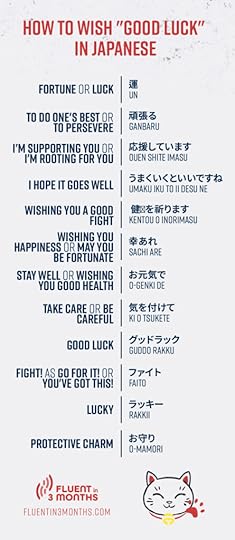 Cultural Insights: Does “Good Luck” Translate Directly?
Cultural Insights: Does “Good Luck” Translate Directly?The Japanese language is full of nouns related to luck or fortune, but they don’t really work as the English expression “good luck.”
In Japanese 運 (un) means “fortune” or “luck.” You can see it used in the phrase 運がいい (un ga ii), which literally means that their “un” is “good.” You can use this to describe people who are lucky. Similarly, there is the noun 幸運 (kouun), which translates to “good fortune” or “good luck.” But in Japanese, it doesn’t really make sense to wish someone to have un or kouun. Why?
Japanese expressions tend to lean more towards actions and efforts that lead to success. The essence of wishing someone well in Japan often centers around the individual’s effort and perseverance. The concepts of 努力 (doryoku, effort) and doing one’s best, 最善を尽くす (saizen o tsukusu) typically are more important the reliance on luck. Japanese culture celebrates the journey and dedication it takes to overcome obstacles, suggesting that we make our own luck through sustained effort and determination.
In other words, Japanese focuses on the fortunate end result of someone’s actions rather than the abstract idea of being graced by luck. It’s similar to recognizing that someone has reaped the rewards of their hard work; the emphasis remains on personal agency rather than sheer chance.
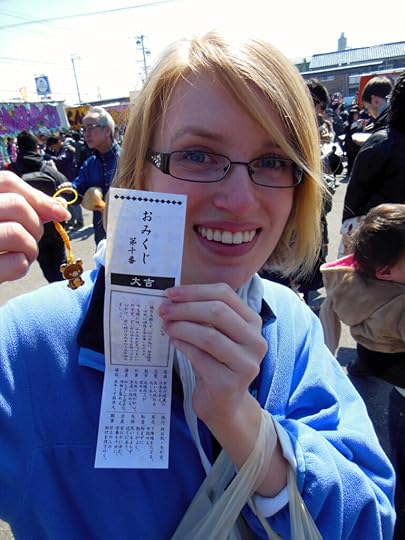
I had my fortune told at a shrine. It said I would be extremely lucky!
Using 頑張る (Ganbaru): The Most Common Ways to Wish Good Luck in JapaneseIn most situations where you would want to wish someone luck in English, Japanese wishes you to 頑張る (ganbaru). Ironically, there’s no literal translation for this word in English. It means something like “to do one’s best.” So here are some common ways to conjugate this word and actually use it in Japanese!
頑張って (Ganbatte) – The Go-To ExpressionThe phrase 頑張って (ganbatte) is one of the most common ways to wish someone good luck in Japanese. Roughly equivalent to “do your best” or “hang in there,” it’s a versatile expression of support used among close friends and family. While it doesn’t directly translate to “good luck,” its underlying sentiment conveys encouragement to put forth one’s best effort, no matter the circumstance.
It’s a bit informal, so if you need to use it with someone higher ranking than you or someone you don’t know well, just add ください (kudasai) to it. So it’ll be 頑張ってください (ganbatte kudasai).
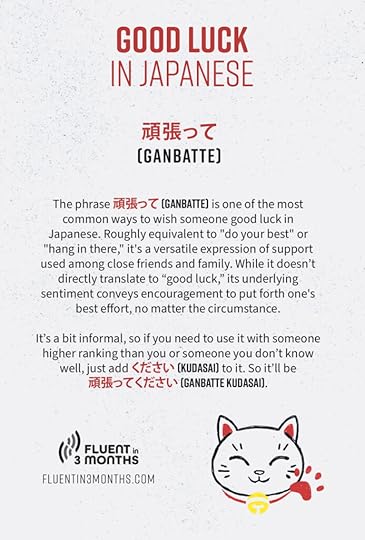 頑張れ (Ganbare) – The Imperative Form of Encouragement
頑張れ (Ganbare) – The Imperative Form of EncouragementA step up in intensity from ganbatte, 頑張れ (ganbare) serves as a rallying cry. It’s 頑張る (ganbaru) in the imperative form, which means it can be a bit rough and rude if used incorrectly since the imperative form of verbs is used much less in Japanese than English.
Like the above, it roughly means “Go for it!” or “You can do it!” and is often shouted from the sidelines during sports events. This expression is also sometimes used among peers or from elders to younger people. But if you don’t quite have a sense of whether it’s okay for you to use it in informal situations, just stick with 頑張って (ganbatte).
Examples of 頑張る (Ganbaru) in ConversationOkay, so you know that 頑張る (ganbaru) is a great verb to use to wish someone luck. So how can we actually use it in a sentence? It’s quite easy!
Here are a few examples of how you can use 頑張る (ganbaru) in sentences to wish someone the equivalent of “good luck.”
Before a friend’s job interview: 「明日の面接、頑張って!」(Ashita no mensetsu, ganbatte!, “Do your best at the interview tomorrow!”)
Cheering at a soccer match: 「いけいけ、頑張れ!」(Ike ike, ganbare!, “Go go, you can do it!”)
To a colleague working on a project: 「このプロジェクト、頑張ってください。」(Kono purojekuto, ganbatte kudasai., “Please do your best on this project.”)
Japanese Expressions for Wishing Good LuckOf course, there are more ways than 頑張る (ganbaru) to wish someone good luck in Japanese! Here are a few more phrases to keep in your arsenal:
応援しています (Ouen Shite Imasu) – Showing Support応援しています (ouen shite imasu) phrase translates to “I’m supporting you” or “I’m rooting for you.” It’s warmer and more personal, often used when you want to express ongoing support for someone’s endeavors, such as a friend involved in a long-term project or embarking on a new venture.
This is the neutral polite way to say it. If you want to show close friends or family members support, you can change it to 応援している (ouen shite iru).
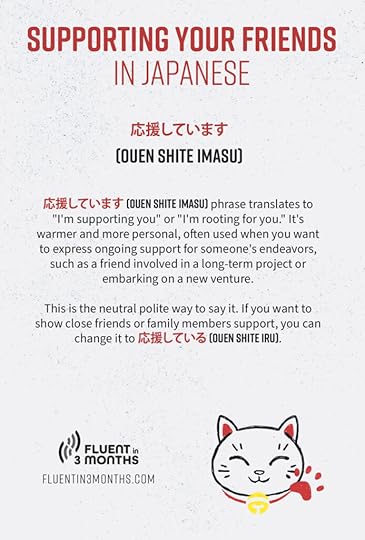 うまくいくといいですね (Umaku Iku to Ii Desu ne) – Hoping for Success
うまくいくといいですね (Umaku Iku to Ii Desu ne) – Hoping for SuccessLiterally meaning “I hope it goes well,” うまくいくといいですね (umaku iku to ii desu ne) softly conveys your wishes for someone’s success. It carries a friendly tone.
Again, this is a neutral polite way to say this phrase. To make it casual, say うまくいくといいね (umaku iku to ii ne).
健闘を祈ります (Kentou o Inorimasu) – For a Good Fight or EffortHere’s a good luck phrase for more formal situations!
When you want to wish someone good luck in a contest or competition, 健闘を祈ります (kentou o inorimasu), which means “I pray for your good fight.” The “praying” part of this makes it quite a bit stiff and not used in everyday conversation much, although it is possible. You might also hear this used in business situations.
Even though this is a polite neutral form of the phrase, you’ll often see the politeness level bumped up even more to ご健闘をお祈りします (go-kentou o orinori shimasu). This might be used in a speech or a toast.
幸あれ (Sachi Are) – A Classical Wish for Happiness幸あれ (sachi are) is a somewhat archaic and poetic way of wishing someone happiness or good fortune. While not common in everyday language, it might be used in a formal speech or a written message (like in a greeting card) to convey a heartfelt wish.
お元気で (O-genki de) – Wishing Good Health or Well-BeingWishing someone お元気で (o-genki de) expresses a sincere wish for their continued health and prosperity. This phrase is often used when parting for a long time or in writing at the end of a correspondence.
気を付けて (Ki o Tsukete) – Wishing Someone Caution or SafetyTranslated to “take care” or “be careful,” this phrase is a common way to express consideration for someone’s safety rather than luck. Use it when a friend is traveling, facing bad weather, or undertaking a potentially risky activity. So where English might wish someone luck, Japanese wishes caution.
This is a casual phrase, so to add formality to it, just add ください (kudasai) at the end.
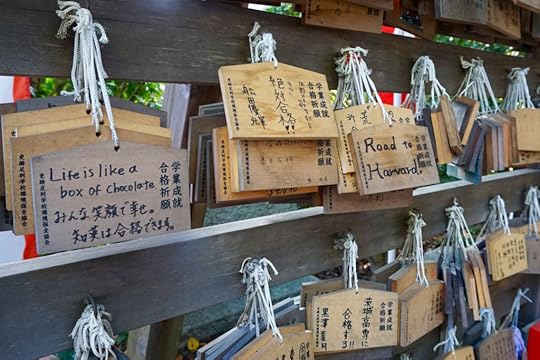
People in Japan will often write what they want good luck for at shrines and temples.
Phrases about Luck in Japanese Derived from EnglishRight, so there’s no exact equivalent inherently in Japanese to wish someone good luck. Japanese speakers enjoy playing with words and will often adopt foreign expressions that succinctly capture a feeling or sentiment that resonates with them. Moreover, such phrases can carry a trendy or modern connotation, making them attractive to especially the younger generations.
So sometimes, an English word can do the trick in Japanese! Here’s what you can use.
グッドラック (Guddo Rakku) – “Good Luck” from EnglishSo sometimes, you might hear the phrase グッドラック (guddo rakku), which is how the Japanese would pronounce the English phrase “Good luck.”
It’s not actually used too much – mostly by young people trying to sound cool (kind of how all Americans might say the Spanish gracias instead of “thank you”). You might also see it in written form or in contexts heavily influenced by Western customs, such as international sports events.
ファイト (Faito) – Casual Encouragement Borrowed from EnglishHere’s another example of when the Japanese love to incorporate trendy foreign words into their language. ファイト (faito), derived from the English word “fight,” is an example of this. Used prominently among young people and in casual settings, it serves as an energetic cheer akin to “Go for it!” or “You’ve got this!”
By the way, if you’re a fan of K-culture, you’ll notice Korean has also had a similar idea. Korean slang has adopted the idea of English “fighting,” so they’ll say 파이팅 (hwaiting) in about the same context!
ラッキー (Rakkii) – Expressing Luck CasuallyHere’s just an add on. We already know that you can say that someone’s 運がいい (un ga ii) to say that they’re “lucky.” You can also use the Japanese-English word for it!
“ラッキー” (Rakkii), directly taken from the English word “lucky,” is a lighthearted way to comment on good fortune in Japan. It’s a な (na) adjective (you can learn more about what I mean by this in our article about Japanese adjectives). It sounds weird, but it might also occasionally be used as a noun.
You might hear this word when someone finds money on the ground or wins a small prize, but it’s not usually the best choice for formal business situations.
Cultural Symbols of Luck and Protection in JapanJapan is rich in symbols believed to bring luck, protection, and good fortune. Here are a few of the most popular good luck symbols and objects in Japanese culture:
お守り (O-mamori) – The Talisman for Luck and Safetyお守り (o-mamori) are amulets typically purchased at Shinto shrines and Buddhist temples throughout Japan. These charms are not just decorative; they serve a spiritual purpose, providing protection or bringing good luck in various aspects of life.
Ranging from success in education to traffic safety, o-mamori are tailored to specific needs or desires. Giving an o-mamori to someone embarking on a new journey or facing a challenge is a thoughtful way of wishing them good luck and safety.
For instance, a student may carry a 学業成就 (gakugyou-jouju) o-mamori to wish for success in their studies, while a traveler might have a 交通安全 (kōtsuu-anzen) o-mamori for safe journeys.
Lucky Animals: Cats, Koi, Cranes, Oh My!There are also various lucky animals in Japanese culture. The 招き猫 (maneki-neko), or “beckoning cat,” is one such charm. Often seen in businesses and homes, this cat figurine with a raised paw is thought to attract customers and prosperity.
Other symbols include the 鯉 (koi), or carp, which symbolizes determination and strength due to its ability to swim upstream; the 鶴 (tsuru), or crane, representing longevity and good fortune; and the 亀 (kame), or tortoise, which is also associated with longevity and luck.

Koi fish are lucky symbols in Japan.
Real-life Dialogues Demonstrating the Use of a Variety of “Good Luck” ExpressionsOkay, so you have a lot of phrases you can use. Here are some sample dialogues demonstrating how you can use them in context!
Situation 1: A Friend Prepares for a Job InterviewA: 明日の面接の準備はどう? (Ashita no mensetsu no junbi wa dou?)
B: うん、ちょっと緊張してる。 (Un, chotto kinchou shite’ru.)
A: 大丈夫、きっとうまくいくよ。頑張って! (Daijoubu, kitto umaku iku yo. Ganbatte!)
Translation:
A: How’s the preparation for tomorrow’s interview?
B: Well, I’m a bit nervous.
A: Don’t worry, it will surely go well. Good luck!
A: 新しいプロジェクトが始まります。おめでとうございます!(Atarashii purojekuto ga hajimarimasu ne. Omedetou gozaimasu!)
B: はい、とてもわくわくしています。 (Hai, totemo wakuwaku shite imasu.)
A: 応援していますよ。健闘を祈ります! (Ouen shite imasu yo. Kentou o inorimasu!)
Translation:
A: You’re starting the new project, right? Congratulations!
B: Yes, I’m very excited.
A: I’m rooting for you. I wish you the best of luck!
A: 明日、テストだね。 (Ashita, tesuto da ne.)
B: うん、勉強たくさんしたから大丈夫かな。 (Un, benkyou takusan shita kara daijoubu kana.)
A: 頑張れ!ラッキーを送るよ! (Ganbare! Rakkii o okuru yo!)
Translation:
A: You have a test tomorrow, right?
B: Yeah, I studied a lot, so I think it’ll be okay.
A: You can do it! Sending you lucky vibes!
A: 明日から旅行ですってね。 (Ashita kara ryokou desu tte ne.)
B: ええ、楽しみにしています。 (Ee, tanoshimi ni shite imasu.)
A: いい旅行になりますように。気を付けて! (Ii ryokou ni narimasu you ni. Ki o tsukete!)
Translation:
A: You’re going on a trip from tomorrow, aren’t you?
B: Yes, I’m looking forward to it.
A: I hope it will be a good trip. Take care!
In each dialogue, the “good luck” expressions are chosen considering the relationship between speakers and the particular situation at hand. It demonstrates how cultural and social cues in Japan dictate not just the message but also the manner in which support and well-wishes are conveyed.
So whether it’s for an interview, a new opportunity, an upcoming test, or a travel adventure, each scenario calls for an expression that goes with the desired sentiment, relationship, and formality level.
Good Luck in JapaneseThroughout this article, we’ve looked at a variety of phrases to wish someone “good luck” in Japanese. Each conveys a unique sentiment, from the broadly used 頑張って (ganbatte) that cheers someone to do their best, to more specific wishes like 気を付けて (ki o tsukete) for caution and safety. We learned not just what to say, but how the cultural context shapes when and to whom these phrases are appropriately directed.
So as you go about your linguistic journey, remember that the phrases you learn are more than just words; they are carriers of culture, respect, and heartfelt sentiment. Use them to connect, encourage, and inspire — and watch as your relationships in the world of Japanese language and culture flourish. Ganbatte!
The post Good Luck in Japanese: How to Offer Encouragement with Cultural Nuance appeared first on Fluent in 3 Months.
February 23, 2024
100+ Essential Greek Words for Beginners
With these 100+ Greek words for beginners, you’ll have everything you need to start speaking Greek.
When I was studying Greek, these words allowed me to read menus, order a coffee or some lunch, and have a basic conversation (with a lot of mistakes, but hey, that’s how we learn!)
I was born in the Turkish-speaking part of Cyprus. If my country wasn’t divided, Greek could have been my second native language. But it isn’t — which led me to take Greek lessons in Cyprus in 2019. At the time, I was working at an NGO aimed at peacebuilding, where I met people who only spoke Greek and no English. My beginners’ Greek came to the rescue! I was able to say phrases like Μιλάω λίγα ελληνικά (mialo liga ellinika), “I speak a little Greek,” and Δουλεύω εδώ (dulevo edo), “I work here,” which became ice-breakers before an English-speaker came over to translate.
So if you want your Greek to go beyond Καλημέρα (kalimera) (“good morning”) on your holidays in Santorini, or you want to get a head start in your Greek language classes, you’re in the right place.
Greek Greetings and PartingsFirst things first — let’s start by learning how to say hello in Greek.
Γεια σου (Yia su): “Hello” (informal)Γεια σας (Yia sas): “Hello” (formal or plural)Χαίρετε (Herete): “Hello” or “Greetings” (formal)Καλημέρα (Kalimera): “Good morning”Καλησπέρα (Kalispera): “Good afternoon”Καληνύχτα (Kalinihta): “Good night”Αντίο (Adio): “Goodbye” Polite Words in Greek
Polite Words in Greek“Thank you” and “please” are among the most important words in any language, and Greek is no exception. You would hear both Ευχαριστώ (efharisto) and Ευχαριστώ πολύ (efharisto poli) a lot.
Παρακαλώ (Parakalo): “Please”Ευχαριστώ (Efharisto): “Thank you”Ευχαριστώ πολύ (Efharisto poli): “Thank you very much”Συγγνώμη (Signomi): “Excuse me”Παρακαλώ πολύ (Parakalo poli): “You’re very welcome” Yes and No in Greek
Yes and No in GreekTwo easy Greek words that can answer many questions: yes and no. Ναι (ne) means “yes,” and oχι (ohi) means “no.” There’s also a specific gesture that means no in Greece, Cyprus, and many other countries nearby:
@greeksaladguy How to say no in Greek #greek #greekamerican #greecetiktok #greektiktok #greeklessons #greekwords #learngreek ♬ original sound – Emmanuel Manolakas
Do this and people will think you’re more than a beginner!
How Are You in GreekΤι κάνεις; (Ti kanis?): “What are you doing?” or “How are you?” (informal)Πώς είσαι; (Pos ise?): “How are you?” (informal)Καλά είμαι (Kala ime): “I’m fine”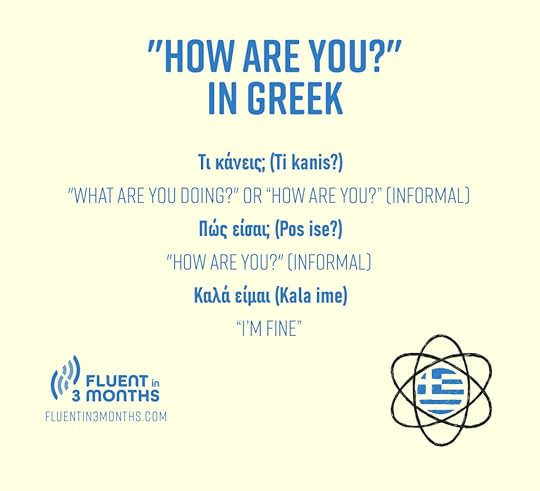 Saying Your Name in GreekΠώς σε λένε; (Pos se lene?): “What is your name?” (informal)Με λένε… (Me lene): “My name is…” (Say me lene followed by your name.)Useful Greek Words for Tourists and Travellers
Saying Your Name in GreekΠώς σε λένε; (Pos se lene?): “What is your name?” (informal)Με λένε… (Me lene): “My name is…” (Say me lene followed by your name.)Useful Greek Words for Tourists and TravellersIt may be super easy to read road signs back at home, but when you’re travelling in Greece or Cyprus, it may seem all Greek to you. Pun intended!
Greece ranked very high on Education First’s Annual English Proficiency Index, so especially in touristy places, you can most likely get away with English. However, by learning some basics, you’ll get to form a deeper connection with the country, go to places beyond the tourist hot spots, and recognize important words in an airport, hotel, or restaurant.
Here are some cool Greek words that will make your trip smoother:
Ταξίδι (taksidi): “Trip”Καλό ταξίδι (kalo taksidi): “Have a nice trip”Διαβατήριο (diavatirio): “Passport”Κράτηση (kratisi): “Reservation”Δωμάτιο (domatio): “Room”Αεροδρόμιο (aerodromio): “Airport”Μπάνιο (banio): “Bathroom”Εστιατόριο (estiatorio): “Restaurant”Ξενοδοχείο (ksenodohio): “Hotel”Τράπεζα (trapeza): “Bank”Φαρμακείο (farmakio): “Pharmacy”Σπίτι (spiti): “House”Αυτοκίνητο (aftokinito): “Car”Λεωφορείο (leoforio): “Bus”Τρένο (treno): “Train”Ταξί (taksi): “Taxi”Μετρό (metro): “Metro”Αεροπλάνο (aeroplano): “Plane”Εισιτήριο (isitirio): “Ticket”Στην ώρα (stin ora): “On time”Καθυστερημένο (kathisterimeno): “Delayed”Αριστερά (aristera): “Left”Δεξιά (deksia): “Right”Ευθεία (efthia): “Straight”Πίσω (piso): “Back”Πάνω (pano): “Up”Κάτω (kato): “Down”Μιλάτε Αγγλικά; (Milate anglika?): “Do you speak English?”Δεν καταλαβαίνω (Den katalaveno): “I don’t understand”Που είναι… (Pu ine): “Where is…” (For example, Που είναι το μπάνιο; means “Where is the bathroom?”)Πόσο κοστίζει αυτό; (Poso kostizi afto?): “How much does this cost?”Τι ώρα είναι; (ti ora ine?): “What time is it?”Μπορώ να πληρώσω με κάρτα; (boro na pliroso me karta?): “Can I pay by card?” Greek Words for Food and Drinks
Greek Words for Food and DrinksWhether you’re ordering some mezze in a Greek tavern or talking about your favourite food in your language class, you’ll need some food vocabulary and common phrases.
Basic Greek Words for Food and DrinksΦαγητό (fagito): “Food”Πρωινό (proino): “Breakfast”Μεσημεριανό (mesimeriano): “Lunch”Δείπνο (dipno): “Dinner”Ψωμί (psomi): “Bread”Τυρί (tiri): “Cheese”Ντομάτα (domata): “Tomato”Πατάτα (patata): “Potato”Ζυμαρικά (zimarika): “Pasta”Αυγό (avgo): “Egg”Κρέας (kreas): “Meat”Ψάρι (psari): “Fish”Κοτόπουλο (kotopoulo): “Chicken”Αλάτι (alati): “Salt”Πιπέρι (piperi): “Pepper”Ζάχαρη (zahari): “Sugar”Καφές (kafes): “Coffee”Τσάι (tsai): “Tea”Νερό (nero): “Water”Κρασί (krasi): “Wine”Μπύρα (bira): “Beer”Γάλα (gala): “Milk”Χυμός (himos): “Juice” Ordering Food or Drinks in Greek
Ordering Food or Drinks in GreekYou can order food with the words we’ve already covered. For example, if you want to get a cup of coffee, you say Έναν καφέ, παρακαλώ (enan kafe, parakalo), “one coffee, please.”
Depending on the grammatical gender of the noun, you might also hear people saying μία (mia.) To order beer, for example, it’s Mία μπύρα, παρακαλώ (mia bira parakalo), “one beer, please.”
In the next sections, we will cover Greek verbs, some of which will also help you order food and drinks. For example, the word Θέλω (thelo), meaning “to want” will come in handy. To make it politer, you can say Θα ήθελα (tha ithela), “I would like.”
Here are some examples:
Θα ήθελα έναν καφέ παρακαλώ (tha ithela enan kafe parakalo): “I would like a coffee, please.”Θα ήθελα μια μπύρα παρακαλώ (tha ithela mia bira parakalo): “I would like a beer please.” Greek PronounsΕγώ (Ego): “I”Εσύ (Esi): “You”Αυτός / Αυτή / Αυτό (aftos / afti / afto): “He / She / It,” used for singular nouns of masculine, feminine, and neuter gender.Εμείς (Emis): “We”Εσείς (Esis): “You” (plural or formal)Αυτοί / Αυτές / Αυτά (Afti / Aftes / Afta): “They” used for plural nouns of masculine, feminine, and neuter gender.
Greek PronounsΕγώ (Ego): “I”Εσύ (Esi): “You”Αυτός / Αυτή / Αυτό (aftos / afti / afto): “He / She / It,” used for singular nouns of masculine, feminine, and neuter gender.Εμείς (Emis): “We”Εσείς (Esis): “You” (plural or formal)Αυτοί / Αυτές / Αυτά (Afti / Aftes / Afta): “They” used for plural nouns of masculine, feminine, and neuter gender.
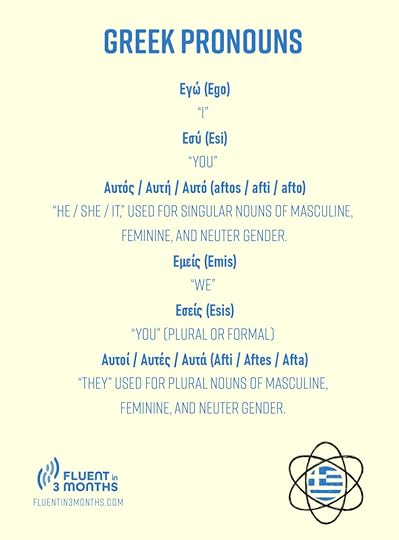 Most Common Greek VerbsΕίμαι (ime): “To be”Έχω (eho): “To have”Κάνω (kano): “To do, to make”Πάω (pao): “To go”Έρχομαι (erhomai): “To come”Τρώω (troo): “To eat”Πίνω (pino): “To drink”Θέλω (thelo): “To want”Αγαπώ (agapo): “To love”Καταλαβαίνω (katalaveno): “To understand”Ξέρω (ksero): “To know”Νομίζω (nomizo): “To think”Βλέπω (vlepo): “To see”Μιλάω (milao): “To speak”Διαβάζω (diavazo): “To read”Δουλεύω (dulevo): “To work”
Most Common Greek VerbsΕίμαι (ime): “To be”Έχω (eho): “To have”Κάνω (kano): “To do, to make”Πάω (pao): “To go”Έρχομαι (erhomai): “To come”Τρώω (troo): “To eat”Πίνω (pino): “To drink”Θέλω (thelo): “To want”Αγαπώ (agapo): “To love”Καταλαβαίνω (katalaveno): “To understand”Ξέρω (ksero): “To know”Νομίζω (nomizo): “To think”Βλέπω (vlepo): “To see”Μιλάω (milao): “To speak”Διαβάζω (diavazo): “To read”Δουλεύω (dulevo): “To work”

These are both the infinitive form and the first-person singular forms of verbs. For example, Δουλεύω means both “to work” and “I work.” Let’s take a look at the following sentences:
Πάω στο αεροδρόμιο (pao sto aerodromio): “I’m going to the airport.”Τρώω ζυμαρικά (troo zimarika): “I eat pasta.”Πίνω τσάι (pino tsai): “I drink tea.”Έρχομαι σπίτι (erhome spiti): “I come home.”Some Common Nouns in GreekIn this part, we’ll cover some nouns in Greek. Notice the articles before them — in Greek, nouns are either masculine, feminine, or neutral. Ο / o (o) is the article for masculine nouns, Η / η (i) is for feminine nouns, and Το / το (to) for neutral nouns.
Το βιβλίο (to vivlio): “The book”Η πόρτα (i porta): “The door”Ο τραπέζι (o trapezi): “The table”Η καρέκλα (i karekla): “The chair”Το αυτοκίνητο (to aftokinito): “The car”Η λάμπα (i lampa): “The lamp”Ο άντρας (o andras): “The man”Η γυναίκα (i gineka): “The woman”Ο ήλιος (o ilios): “The sun”Ο φεγγάρι (o fengari): “The moon” Most Common Greek AdjectivesΚαλός (kalos): “Good”Κακός (kakos): “Bad”Μεγάλος (megalos): “Big”Μικρός (mikros): “Small”Ζεστός (zestos): “Hot”Κρύος (kryos): “Cold”Όμορφος (omorfos): “Beautiful”Άσχημος (ashimos): “Ugly”Ψηλό (psilo): “Tall”Κοντός (kontos): “Short”Εύκολος (efkolos): “Easy”Δύσκολος (diskolos): “Difficult”Ακριβός (akrivos): “Expensive”Φτηνός (ftinos): “Cheap”Νέος (neos): “New”Παλιός (palios): “Old”Ευτυχισμένος (eftihismenos): “Happy”Λυπημένος (lipimenos): “Sad”Γρήγορος (grigoros): “Fast”Αργός (argos): “Slow”
Most Common Greek AdjectivesΚαλός (kalos): “Good”Κακός (kakos): “Bad”Μεγάλος (megalos): “Big”Μικρός (mikros): “Small”Ζεστός (zestos): “Hot”Κρύος (kryos): “Cold”Όμορφος (omorfos): “Beautiful”Άσχημος (ashimos): “Ugly”Ψηλό (psilo): “Tall”Κοντός (kontos): “Short”Εύκολος (efkolos): “Easy”Δύσκολος (diskolos): “Difficult”Ακριβός (akrivos): “Expensive”Φτηνός (ftinos): “Cheap”Νέος (neos): “New”Παλιός (palios): “Old”Ευτυχισμένος (eftihismenos): “Happy”Λυπημένος (lipimenos): “Sad”Γρήγορος (grigoros): “Fast”Αργός (argos): “Slow”

Let’s make some sentences using these adjectives, and probably the most common verb in Greek — είναι (ine) “to be.” We’ll also make sure to change the adjectives’ ends depending on the noun’s gender.
Το βιβλίο είναι ακριβό. (to vivlio ine akrivo): “The book is expensive.” (Το βιβλίο is neutral so the adjective is in neutral form.)Άννα είναι ψηλή (Anna ine psili): “Anna is tall” (Άννα is a woman so the adjective is in feminine form.)Ο καφές είναι ζεστός (O kafes ine zestos): “The coffee is hot.” (Ο καφές is masculine so the adjective is in masculine form.Basic Greek Prepositions and ConjunctionsΚαι (ke): “And”Ή (i): “Or”Από (apo): “From”Σε (se): “To”Για (yia): “For”Με (me): “With”Χωρίς (horis): “Without”Πάνω (pano): “On”Κάτω (kato): “Under”Πριν (prin): “Before”Μετά (meta): “After/later”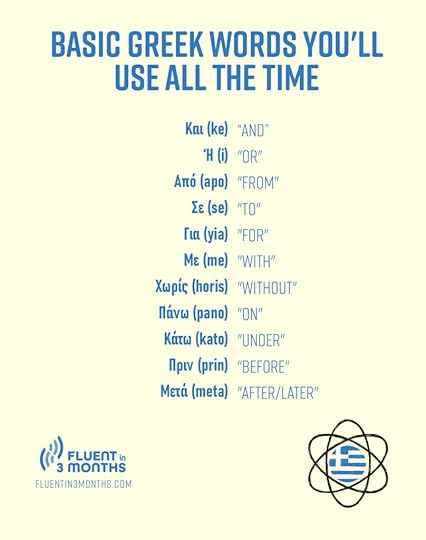
Now, let’s order coffee again!
Έναν καφέ με ζάχαρη, παρακαλώ. (enan kafe me zahari, parakalo): “One coffee with sugar, please.”Έναν καφέ με γάλα, παρακαλώ. (enan kafe me gala, parakalo): “One coffee with milk, please.”Έναν καφέ χωρίς γάλα και ζάχαρη, παρακαλώ. (enan kafe horis gala ke zahari, parakalo): “One coffee without milk and sugar, please.”Greek Numbers 1-10Numbers in Greek will help you understand the prices of things, the time, someone’s phone number, and many more. Learning the numbers from 1 to 10 is a good start.
1. Ένα (ena): “One”2. Δύο (dio): “Two”3. Τρία (tria): “Three”4. Τέσσερα (tessera): “Four”5. Πέντε (pende): “Five”6. Έξι (eksi): “Six”7. Επτά (epta): “Seven”8. Οκτώ (okto): “Eight”9. Εννέα (ennea): “Nine”10. Δέκα (deka): “Ten”Now, Today, Tomorrow, and Yesterday in GreekΤώρα (tora): “Now”Σήμερα (simera): “Today”Αύριο (avrio): “Tomorrow”Χθες (hthes): “Yesterday”Days of the Week in GreekΔευτέρα (deftera): “Monday”Τρίτη (triti): “Tuesday”Τετάρτη (tetarti): “Wednesday”Πέμπτη (pempti): “Thursday”Παρασκευή (paraskevi): “Friday”Σάββατο (savvato): “Saturday”Κυριακή (kiriaki): “Sunday” Months in GreekΙανουάριος (ianuarios): “January”Φεβρουάριος (fevruarios): “February”Μάρτιος (martios): “March”Απρίλιος (aprilios): “April”Μάιος (maios): “May”Ιούνιος (iunios): “June”Ιούλιος (iulios): “July”Αύγουστος (avgustos): “August”Σεπτέμβριος (septemvrios): “September”Οκτώβριος (oktovrios): “October”Νοέμβριος (noemvrios): “November”Δεκέμβριος (dekemvrios): “December”
Months in GreekΙανουάριος (ianuarios): “January”Φεβρουάριος (fevruarios): “February”Μάρτιος (martios): “March”Απρίλιος (aprilios): “April”Μάιος (maios): “May”Ιούνιος (iunios): “June”Ιούλιος (iulios): “July”Αύγουστος (avgustos): “August”Σεπτέμβριος (septemvrios): “September”Οκτώβριος (oktovrios): “October”Νοέμβριος (noemvrios): “November”Δεκέμβριος (dekemvrios): “December”
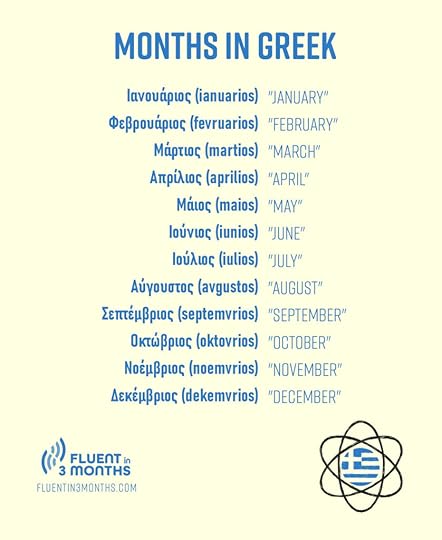 Seasons in GreekΆνοιξη (anixi): “Spring”Καλοκαίρι (kalokeri): “Summer”Φθινόπωρο (fthinotoro): “Autumn”Χειμώνας (himonas): “Winter”
Seasons in GreekΆνοιξη (anixi): “Spring”Καλοκαίρι (kalokeri): “Summer”Φθινόπωρο (fthinotoro): “Autumn”Χειμώνας (himonas): “Winter”
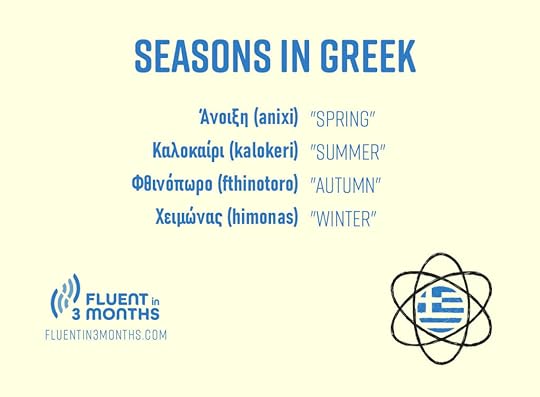 Take Your Time While Learning Greek
Take Your Time While Learning GreekWe’ve covered a lot in this article. Feel free to bookmark it and check it out as you need. Take your time, make sure to practise your Greek pronunciation with videos and audios, and continue immersing yourself in the language!
Learn Greek Online: 39 Free Resources and Classes to Learn the Greek Language40+ Cool Greek Words That Will Make You Want to Learn GreekBlack Friday Deals for Greek Language CoursesHow to Say Hello in Greek (And 30+ Other Greetings in Greek)28 Synonyms for Love from Around the World (+ Literal Translations into English)The post 100+ Essential Greek Words for Beginners appeared first on Fluent in 3 Months.
February 16, 2024
The 9 Best Japanese Translator Tools: Websites, Apps, and Dictionaries
Whether you’re simply building your own language skills or doing professional translation work, picking the best Japanese translator can be tricky. Which ones are the most accurate? Which ones have the specialized vocabulary you need? And how reliable are AI and automatic translators?
I’ve worked in Japanese translation in so many different contexts over the years, both in Japan and the US. Professionally, I’ve dabbled in a variety of works, including translating and interpreting TV shows and movie subtitles, executive-level meetings of all levels at a manufacturing company, political news coverage, and cultural heritage sites for tourism.
In this article, I’ll introduce you to some of the most popular translator websites and apps. I’ll also provide guidance on how to find specialized dictionaries and translators if you need them. So let’s get to it!
function runSplitTest(){var randomNumber = Math.floor(Math.random() * 2) + 1console.log(randomNumber)var copy = "";if (randomNumber == 3){ copy = '<i>A note from the Fluent in 3 Months team before we get started: You can chat away in Japanese for at least 15 minutes with the "Fluent in 3 Months" method. All it takes is 90 days. <b><a href="https://fluentin3months.com/challenge... this link to find out more.</b></a></i>'} else { copy = '<i>Editor's note: Before we get started, if you’re looking for an online Japanese course, here’s the course we recommend: <a href="https://www.fluentin3months.com/olly-... Uncovered - Learn Japanese Through the Power of Story</b></a>, a course with a fascinating new method by Olly Richards. You can try it for free for 7 days!</i>'}console.log(copy)var copyToChange = document.querySelector("p.copyText").innerHTML = copy;}runSplitTest();Table of contentsThe Best Japanese Translation Dictionary for English Speakers: WWWJDIC (and Variants)The Best Japanese Machine Translation Site: Google TranslateThe Up and Coming Japanese Machine Translator: ChatGPTThe Best Japan-Based Translator: WeblioCATs: Computer Assisted Translation ToolsFinding Other Specialized Japanese TranslatorsHuman Translators: The Only Way to Get the Nuance RightReady to 翻訳 ( Hon’yaku / Translate)?The Best Japanese Translation Dictionary for English Speakers: WWWJDIC (and Variants)If you’re looking for a good Japanese translator app or website, look no further than those based on the Australian academic Jim Breen’s amazingly thorough project WWWJDIC. This is a Japanese-English and English-Japanese dictionary – and much, much more!
You may know this website by another name. For example, WWWJDIC powers popular dictionaries such as Jisho.org, the imiwa? app, and the Yomiwa app.
(While most Japanese learners I’ve met prefer the interface of Jisho.org, I’m quite loyal to the WWWJDIC website. Maybe I’m a bit of a purist. But it doesn’t matter – either site will basically allow you to do all of the exciting things I’m about to tell you!)

The main dictionary has about 180,000 entries – and that’s a lot! Massive, really! Many vocabulary and phrase entries show multiple ways to read and write the word (for example, if the same word might have multiple possible pronunciations or kanji) and example sentences. This way, you can see how words are used in context or how they might be translated in different ways.
WWWJDIC even includes translations of specialized terminology, such as those in fields such as medicine, engineering, law, and Buddhism. Amazing!
WWWJDIC also has an extensive Japanese surname database. This is incredibly useful since Japanese names often break or bend the rules for kanji readings!
Speaking of which, WWWJDIC also has an extensive overall kanji database. It can even help you break down and identify kanji based on the JLPT (Japanese Language Proficiency Test) or the most commonly used kanji, for example.
While WWWJDIC isn’t a “translator” at heart, it is an essential tool for anyone working on a Japanese translation. You will always need a good dictionary. I also include it for two more reasons:
First, it has some translation entries for set phrases or idiomatic expressions. This is a great resource for identifying kotowaza, or Japanese proverbs, which might not seem obvious when put into a translation machine!
Also, it also has a handy “text glossing” feature. On this page, you can input a lengthier text, and it will help you identify and translate core words and grammar patterns. This is incredibly helpful if you are translating a passage and don’t want to look up each word one at a time. (This is called “text reading assistance” on Jisho.org, but I honestly feel like WWWJDIC does a better job at this one.)
Notable competitors:
Honestly, for English speakers, WWWJDIC has none in terms of English-Japanese and Japanese-English dictionaries. It powers many websites and apps, so you can choose which one you like the best. Its only real competition is some websites for Japanese speakers like Weblio, which I explain in a later section.The Best Japanese Machine Translation Site: Google TranslateOver the last several years, Google Translate has become a very accurate Japanese translator. It’s available as both a website and app for iOS and Android.
Google has made some great investments in its translation abilities between English and Japanese, and it has paid off! I remember the days when it would just translate word for word and come up with gibberish. Now, it can translate even complex or relatively nuanced passages!
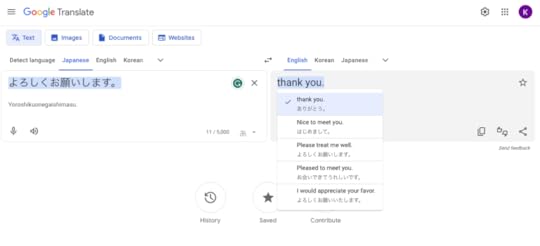
Not only can it translate relatively long passages very quickly, but it’s also quite accurate! The machine voices can produce audio that sounds relatively human, and the app can also translate text from your camera in real time.
Keep in mind that there are some things Google Translate (and indeed, any machine translation) still struggles with regard to Japanese translation. Since Japanese is a very context-dependent language – for example, it often leaves out the subject of a sentence – there are simply things machine translators won’t get right.
It also works better with structured language. For example, in my experience, it translates news articles (which are often written in quite clear language) better than colloquial speech (which might be the most context-dependent of all)!
So, always double-check the translation it produces. It doesn’t always understand nuances or context!
Notable competitors:
DeepL is the main competitor for Google Translate. It can translate emails and documents, like PowerPoint files, and offers some CAT tools (or Computer Assisted Translation tools, as discussed a bit further down). However, most of its features are in its paid version, so it’s not as accessible as Google Translate.Those loyal to Microsoft may want to use Bing’s Microsoft Translate, but honestly, it’s just not as developed for English-Japanese pairings.The Up and Coming Japanese Machine Translator: ChatGPTYou’re probably wondering about how AI is going to change the landscape of the Japanese translation world. Honestly, so am I! Even a lot of professional CAT tools and other machine translators are now using AI.
AI and what it can do is changing constantly. As of now, ChatGPT can translate between Japanese and English. Here’s the lowdown of how the free version of ChatGPT does currently.

Pros:
You can interact with it and give it context to the translation. This is different from Google Translate (although sometimes Google Translate allows you to choose from multiple translation options). This is very important in highly contextual languages such as Japanese, since the meaning of a sentence might vary depending on the context.If you think something is wrong in the translation it produces, you can give it feedback and have it edit its translation. This includes asking it to revise things like its vocabulary, fluency, or accuracy.Like Google Translate, it’s quick! Enough said.Cons:
While paid pro versions are becoming more specialized with translation, ChatGPT was not made with translation explicitly in mind, like Google Translate. It relies on patterns of information it’s fed, and sometimes it produces inaccurate or inappropriate content. Since Google Translate is putting a lot of emphasis on Natural Language Processing, it still might have a slight edge in some cases.In relation, ChatGPT’s output is still highly reliant on how you prompt it. Therefore, depending on what you input, the quality of its output may vary significantly. This may be a challenge until you find the right prompting method for your needs.While ChatGPT can work with complicated and long translations, it tends to work well with less complex translations. Since it was made with translation in mind, Google Translate still seems to have an edge with longer passages.So the bottom line here is that ChatGPT is an emerging translation tool. It is promising and worth comparing with Google Translate, but definitely check out our warnings about machine translation later on in the article!
The Best Japan-Based Translator: WeblioI’ve talked about dictionaries made by native English speakers translating into Japanese. It’s worth mentioning the reverse – dictionaries made by native Japanese speakers translating into English!
Weblio is the winner here. It is a comprehensive Japanese-English pair dictionary made for Japanese native speakers. Like WWWJDIC, it also has a lot of specialized terminology.
Unlike the above, Weblio mostly acts as a dictionary of English words, explaining their meanings and nuances in Japanese. This makes it somewhat more useful for native Japanese speakers translating to or from English. You’ll also need to be comfortable navigating a website in Japanese to use it.
But there’s a part of the website that’s incredibly useful for English-native (or non-Japanese native) speakers, too.
By far, the most useful tool of this site is its ample example sentences. By searching for a key term or phrase, you can usually find several if not hundreds of example phrases and sentences with that word in use, translated into both English and Japanese. As I talked about in a previous section, this is incredibly helpful for seeing how words and nuances are conveyed in context!
The sentences and phrases usually differ from what’s on WWWJDIC, so it’s worth having a couple of dictionaries and translators at hand.

Notable competitors:
Eijiro (英辞郎) is in my mind Weblio’s main competitor. Eijiro is a tool developed for Japanese speakers translating content into English. Like Weblio, its main sticking feature is its wealth of example sentences and phrases. I actually personally find its example sentences easier to search through and more robust than Weblio.The downside is that whereas this website used to be free, accessing most of the example sentences now requires a subscription. That’s why Weblio wins this category, since it’s still free.
CATs: Computer Assisted Translation ToolsNow, if you are a professional Japanese translator, you might want to invest in a CAT, or a Computer Assisted Translation, tool. These are widely used by translators to enhance efficiency and maintain consistency in their work.
They often offer features like translation memory, localization glossaries, terminology management, collaborative translation, and quality assurance checks. By storing and streamlining translation information, they can help automate the translation process for the human translator.
These can be important if you are translating a big project, such as a novel or a television series, and need to translate names and terms consistently throughout. This is especially so if multiple people are working on the same project!
For example, I worked on a translation of a Japanese fantasy anime series with another translator (whom I had no direct interaction with and couldn’t discuss terms). We were translating subtitles for the same show but different episodes at the same time. We had to make note of how we translated names, places, and catchphrases in a shared spreadsheet to make sure we both used the same translation consistently. It was easy to mess up, and quite a headache! Having a CAT tool could have helped with these issues.
With the rapid developments of AI, CAT tools are changing at a very quick pace, including pricing. There are also so many on the market it’s difficult to select which one is the best over others. For example, DeepL provides many of the CAT tools above. So it’s best for you to look at what’s on the market and decide what the right one is for your (and possibly your team’s) needs. For a starting point, Benny talks about some in his article about how to become a location-independent freelance translator!
Finding Other Specialized Japanese TranslatorsWhen working as a Japanese translator, there are relatively few resources geared for native English speakers. Sometimes you might not find the right specialized dictionary, no matter how hard you search for it in English.
For example, WWWJDIC doesn’t have a significant repository of accountancy words and phrases. This is quite a difficulty if you need to translate or learn how to translate accounting!
Actually, sometimes you might have the best luck looking for Japan-based translation websites or dictionaries meant to support Japanese translators working with English. Weblio might have the phrases you need in its database, but in case it doesn’t, you can do a targeted internet search.
For example, the term “to close an account” means something different in an accounting department at a company compared to its use at a bank. In the former context, it’s a specialized accountancy phrase related to processing financial records (one possible translation is 計算を締め切る, keisan wo shimekiru). In the latter context, it’s completely different and something an average citizen might do – close a bank account (口座を閉じる, koza wo tojiru). You’ll likely find a translation for the latter in dictionaries. What if you don’t know the former?
You can go to your preferred search engine and type in “close accounts” with vocabulary related to the field you are translating in, such as 経理部 (keiribu, “accounting department [of a company]”). You might find some blogs or less-known websites with the specialized translations you need on Japanese websites. AI might also be increasingly helpful for this.
It might also be worth checking Japanese bookstores, since they often have very useful physical dictionaries of specialized fields. These are often to help Japanese employees learn English phrases for their international work environments.
For example, Toyota has streamlined a lot of its translations of its philosophy and work processes for its global hubs and suppliers. When I worked as a translator at one, I found this book to be very helpful.
So it’s worth looking around at multiple sources to find the right specialized translation assistance tools for you!
Human Translators: The Only Way to Get the Nuance RightAlthough machines are now becoming more and more accurate Japanese translators, human translators are still very important. This is because AI still has no way to fully understand the context, nuances, and complexity of human interaction. And not understanding your target audience’s language and culture well can cost your business millions!
This is especially important when doing localization projects. These go beyond just direct translation. Localization is the adaptation of content to the cultural and contextual expectations of the target audience. It considers factors such as regional differences, cultural sensitivities, and user preferences. So it’s like combining translating, copyrighting, and editing of the content for the intended culture.
All in all, AI might be able to help with the direct translation, but humans are still absolutely necessary for the most accurate translations and localization! After all, not all accurate translations are direct.
Ready to 翻訳 (Hon’yaku / Translate)?So if you are going to do Japanese translation, you will probably use a mix of the above tools! Machine translations can often quickly give you an idea of the meaning of the sentence, and dictionaries will help you understand the nuances of words. It’s the human’s job to put everything together.
With these tools, you should be ready to get started with accurate Japanese translations. Good luck!
The 7 Best Korean Translator Apps for Korean LearnersHow to Learn a Language like GoogleChallenges in the Philippines + video in TagalogHow to become a location-independent freelance translatorMy background before becoming a location-independent freelance translatorThe post The 9 Best Japanese Translator Tools: Websites, Apps, and Dictionaries appeared first on Fluent in 3 Months.
February 9, 2024
11 Great Japanese Cartoons for Japanese Learners of All Ages (Series and Movies!)
Do you think Japanese cartoons are just for children? Think again!
In Japan, cartoons are called “anime” (アニメ), which is short for the Japan-ized word for animation, (animeshon, アニメーション).
In English, “anime” refers to cartoons made in Japan or in the Japanese style. But in Japan, “anime” refers to any kind of animated cartoon. So the Japanese even call American cartoons “anime”, although they’re definitely not as popular as Japanese cartoons!
In the West, cartoons are usually produced for children. But in Japan, anime is not only for children. As we’ll see, some deal with very adult themes!
So if you’re learning Japanese, you’ll certainly want to watch some Japanese cartoons. Here are some of my recommendations for series and movies. Plus, at the end of this article, I’ll also tell you where to watch them and how you can use anime to help you learn Japanese – and how to avoid a big mistake learners might make!
function runSplitTest(){var randomNumber = Math.floor(Math.random() * 2) + 1console.log(randomNumber)var copy = "";if (randomNumber == 3){ copy = '<i>A note from the Fluent in 3 Months team before we get started: You can chat away in Japanese for at least 15 minutes with the "Fluent in 3 Months" method. All it takes is 90 days. <b><a href="https://fluentin3months.com/challenge... this link to find out more.</b></a></i>'} else { copy = '<i>Editor's note: Before we get started, if you’re looking for an online Japanese course, here’s the course we recommend: <a href="https://www.fluentin3months.com/olly-... Uncovered - Learn Japanese Through the Power of Story</b></a>, a course with a fascinating new method by Olly Richards. You can try it for free for 7 days!</i>'}console.log(copy)var copyToChange = document.querySelector("p.copyText").innerHTML = copy;}runSplitTest();Table of contents8 Must-Watch Japanese Anime SeriesDoraemon – ドラえもん ( Doraemon )Sazae-san – サザエさん ( Sazae-san )Crayon Shin-chan – クレヨンしんちゃん ( Kureyon Shin-chan )Naruto – ナルト ( Naruto )One Piece – ワンピース ( Wan Pisu )Aggretsuko – アグレッシブ烈子 ( Aguresshibu Retsuko )Golden Kamuy – ゴールデンカムイ ( Goruden Kamui )Attack on Titan – 進撃の巨人 ( Shingeki no Kyojin )3 Must-Watch Japanese Anime MoviesMy Neighbor Totoro – となりのトトロ ( Tonari no Totoro )Spirited Away – 千と千尋の神隠し ( Sen to Chihiro no Kamikakushi )Where to Watch Japanese CartoonsHow to Study Japanese through CartoonsNote: Beware of Anime-Only Japanese!Find Your Favorite Japanese Cartoon8 Must-Watch Japanese Anime SeriesAnime series feature some of the most beloved Japanese cartoon characters! If you turn on a television or streaming service in Japan, you’ll find no shortage of anime series. Here are some great ones to get you started! (FYI, I’ll start with some of the most family-friendly shows first.)
Doraemon – ドラえもん (Doraemon)
You can’t go to Japan without seeing images of Doraemon everywhere!
Doraemon, a blue robotic cat from the future, is a classic character in Japanese anime culture. He comes from the 22nd century to help a young boy named Nobita with his daily struggles. Doraemon has a magical pocket from which he can pull out a massive array of futuristic gadgets to help Nobita in solving problems, doing homework, and thwarting bullies.
Through their adventures, Doraemon teaches Nobita valuable lessons about friendship, courage, and perseverance. The show often ends on a humorous note, frequently due to the unintended consequences of using Doraemon’s gadgets!
Sazae-san – サザエさん (Sazae-san)
“Sazae-san” is an iconic staple of Japanese television. Actually, this is an understatement – it’s the longest-running animated series in the world!
This show chronicles the everyday life of Sazae Fuguta, a cheerful and energetic woman, as she navigates postwar Japanese society. It offers a glance into the life of a traditional Japanese household where Sazae lives with her husband, son, daughter, her parents, and her younger brother. (Phew! What a household.)
The plot revolves around the family’s simple domestic adventures, capturing the essence of the everyday highs and lows of family life. From dealing with nosy neighbors to addressing generational conflicts and the various challenges of raising children, “Sazae-san” offers a slice-of-life experience with heartwarming humor and relatable situations.
The show’s longevity and popularity are a testament to its ability to adapt to changing times while maintaining the core values of family and community.
Crayon Shin-chan – クレヨンしんちゃん (Kureyon Shin-chan)
“Crayon Shin-chan” is another long-standing success. This show follows the antics of Shin, a mischievous five-year-old boy with a penchant for irreverence and causing trouble. Living with his parents, baby sister, and dog in suburbia, Shin’s actions often result in hilarious, awkward, and sometimes risqué situations.
“Crayon Shin-chan” is known for its satirical take on Japanese culture, adult humor (despite its child protagonist), and a candid portrayal of family dynamics and childhood. (Frankly, you’ll see a lot of mooning, so many Japanese parents are reluctant to let their young children watch it!) But the show balances its edgy humor with moments of warmth and family values, making it a longstanding favorite across generations.
Naruto – ナルト (Naruto)
“Naruto” is a fascinating anime series that centers on the journey of Naruto Uzumaki, a young, boisterous ninja with a dream to become the strongest leader in his village. The catch? Naruto isn’t your typical ninja hopeful — he is the host of the Nine-Tails Fox, a powerful creature that once attacked his village, causing the villagers to treat him with suspicion and fear.
The series, rich with ninja action, adventure, and Japanese folklore, follows Naruto as he trains at the Ninja Academy, forms bonds with his teammates, and learns from his wise mentor. Throughout his quest, he confronts challenges that teach him about the value of friendship, perseverance, and self-discovery.
“Naruto” is a story of underdog determination and growth, intertwining epic battle scenes with heartfelt moments. The anime is beloved for its complex characters, intricate world-building, and themes of acceptance and striving to improve oneself.
One Piece – ワンピース (Wan Pisu)
“One Piece” chronicles the adventures of the young pirate Monkey D. Luffy on his quest for the legendary One Piece treasure in order to become the next Pirate King. Along with his diverse crew, the Straw Hat Pirates, Luffy sails through treacherous waters, encountering other pirates, the strong-willed Navy, and various other friends and foes. Oh, and did I mention Luffy has a body made of rubber?
Through each adventure, the crew members explore their pasts, develop strong bonds, and confront personal aspirations while navigating the dangers of a world ruled by the World Government and other pirate factions. With over 1,000 episodes, be careful to take breaks in between binges!
Aggretsuko – アグレッシブ烈子 (Aguresshibu Retsuko)
Next up, we have a few Japanese adult cartoons. “Aggretsuko” (short for “Aggressive Retsuko”) is a Netflix series made by Sanrio – you know, the creators of Hello Kitty. It revolves around Retsuko, a twenty-something anthropomorphic red panda, as she tackles the daily grind of her often frustrating job as an office worker in a Japanese company.
To cope with her stressful work life and the societal pressures that come with being a single woman in Tokyo, Retsuko has a unique (though secret) outlet: she vents her frustrations through passionate death metal karaoke sessions after hours.
“Aggretsuko” deftly combines humor and heart to comment on the challenges of modern Japanese work culture, the struggles of young adulthood, and the pursuit of personal happiness.
Golden Kamuy – ゴールデンカムイ (Goruden Kamui)
Have you heard of the Ainu, an indigenous group in Japan? Here’s a great opportunity to learn more about their culture and historical context through a gripping anime!
“Golden Kamuy” is an action-packed anime set in the post-Russo-Japanese War era of early 20th century Hokkaido. The story follows Saichi Sugimoto, a battle-hardened veteran, as he seeks to unearth a stash of hidden Ainu gold to fulfill a promise made to his fallen comrade.
After discovering a cryptic map tattooed on the bodies of escaped prisoners, Sugimoto joins forces with a young Ainu girl named Asirpa. Asirpa is not only skilled in survival but is also deeply knowledgeable about her indigenous culture. She has personal stakes in the hunt, seeking to reclaim her people’s stolen wealth.
Together, they embark on a dangerous quest through the wilderness of Hokkaido, confronting not just the harsh elements, but also other treasure hunters, criminals, and the persistent Japanese military. Created in consultation with the Ainu people, “Golden Kamuy” is a tale of survival that provides an insightful exploration of the Ainu culture, featuring a rich cast of characters and a mix of humor, brutality, and historical intrigue.
Attack on Titan – 進撃の巨人 (Shingeki no Kyojin)
“Attack on Titan” is a dark fantasy anime that has captured the imagination of viewers worldwide. The story is set in a world where humanity resides within enormous walled cities to protect themselves from the Titans, gigantic humanoid creatures who devour humans seemingly without reason. The narrative follows Eren Yeager, his adoptive sister Mikasa Ackerman, and their friend Armin Arlert.
After a Titan destroys his town and eats his mother, Eren vows to join the Scout Regiment to fight back against the Titans. Driven by a burning desire for revenge and the hope of freedom, Eren, Mikasa, and Armin face the horrors of the world beyond their walls, as well as the dark secrets of their society and the true nature of the Titans.
“Attack on Titan” is lauded for its intense action sequences, complex characters, moral dilemmas, and intricate plot laden with political intrigue, shocking twists, and revelations about the Titans’ origins. It stands out for questioning the cycles of violence and the consequences of vengeance in a grim, unforgiving world.
3 Must-Watch Japanese Anime MoviesOf course, not all Japanese cartoons are series! There’s also a rich culture of anime movies. Here are some of the most notable ones to get you started.
And if you’re craving more, definitely look into Studio Ghibli films – they’re basically the Disney of Japan! Many of the anime series listed above also have movie spinoffs.

You can see Totoro peeking out from the Ghibli Museum in Mitaka, near Tokyo!
My Neighbor Totoro – となりのトトロ (Tonari no Totoro)
“My Neighbor Totoro” is a cherished Studio Ghibli film that tugs at the heartstrings with its portrayal of childhood innocence and the magic of nature. The story unfolds through the eyes of two young sisters, Satsuki and Mei, as they move to the countryside with their father to be closer to their hospitalized mother.
Exploring their new rural surroundings, Mei stumbles upon a forest spirit named Totoro, a gentle and whimsical creature that embodies the beauty and mystery of the natural world. But weird – adults can’t see him!
Appropriate for all ages, “My Neighbor Totoro” is a heartwarming tale that celebrates family, friendship, the wonders of nature, and the imagination of children.

I also saw Satsuki and Mei’s house in Nagakute-shi, near Nagoya!
Spirited Away – 千と千尋の神隠し (Sen to Chihiro no Kamikakushi)
“Spirited Away” was more than a success – this international award-winning movie was actually the highest grossing film in Japanese history! (Its title was only usurped in 2020 by the “Demon Slayer” movie.)
Another Studio Ghibli film, “Spirited Away” follows the story of a young girl named Chihiro. When her family stumbles upon a seemingly abandoned amusement park on their way to a new home, her parents are transformed into pigs by a mysterious curse after carelessly indulging in food meant for the gods.
As another consequence, Chihiro finds herself stranded and forced to work in a luxurious bathhouse for the gods, owned by the witch Yubaba. To rescue her parents and return to the human world, Chihiro must navigate this complex spirit world, where she encounters a host of unique and captivating characters.
Rich in Japanese folklore, “Spirited Away” features gorgeous animation and themes of environmentalism, greed, and the resilience of the human spirit.
Your Name. – 君の名は。 (Kimi no Na wa.)
“Your Name.” only trails behind “Spirited Away” in terms of box office success! Inspired by Japan’s frequent natural disasters, “Your Name.” is visually stunning and emotionally charged. The story follows two high school students: Mitsuha, a girl living in the rural town of Itomori, and Taki, a boy residing in bustling Tokyo.
The two inexplicably begin to switch bodies, waking up in each other’s lives with no knowledge of how or why this is happening. Although they never meet, they find ways to communicate and become close. But suddenly, the body-swapping stops. Taki then goes on a quest to find Mitsuha, uncovering a deeper, fateful connection tied to a celestial event.
“Your Name.” is a poignant tale about connection, memory, and the lengths one will go to reunite with someone they’ve come to cherish deeply.
Where to Watch Japanese CartoonsNow you might be wondering, “Where can I find Japanese cartoons?”
Nowadays, you have so many ways to watch Japanese anime! I remember when I was a teenager studying Japanese, the only option I knew of was Cartoon Network, and they were all dubbed in English! Of course, some television stations still have anime, but the best ways to watch are on streaming platforms.
Why? Because you can usually watch them in the Japanese original with subtitles in the language of your choice! Listening to the original Japanese is a great way for you to learn the language in a fun and engaging way.
Some of the best ways to stream anime include:
Crunchyroll: Crunchyroll probably has the largest library of anime and is great for serious lovers of anime. It categorizes anime into different genres so you can easily find a cartoon that fits your tastes.Of course, there are other anime-specific and mainstream streaming sites out there, but these have some of the widest options globally and have strong reputations.
How to Study Japanese through CartoonsOkay, so you’ve found a Japanese cartoon you want to watch. How can you optimize this for learning Japanese?
Now, let me say there’s nothing wrong with watching Japanese anime in English. You can still probably pick up some cultural tidbits. But the best way to learn Japanese through anime is by using a more active approach. I recommend this:
First, watch the anime with Japanese audio without English subtitles. Especially if you are just starting out, this doesn’t need to be an entire movie or episode. It can be just one scene or clip if you’d like!This method takes some active learning, but it’s a great way to build up and practice your Japanese vocabulary, grammar, and listening skills!
Note: Beware of Anime-Only Japanese!Now, keep in mind: Sometimes the Japanese you’ll come across in anime is not used in real life. Characters might speak in odd ways or even makeup words! This is all part of the world-building aspect of anime. (If you played certain Japanese video games, like Animal Crossing, you’ll see these used even in the English translations!)
For example, characters might make up their own gobi (語尾), or sentence-ending particles (think yo / よ or wa / わ). In Chibi Maruko-chan, the pig-like character Butaro often ends sentences with bu (ブー), which is the sound a pig makes!
Another thing to watch out for is grammar. Especially in action-heavy anime, male characters in particular tend to talk in quite a rough way. They often use the imperative form, which is often incredibly rude to use in real-life Japanese and should be used with caution. For example, they often use kurae (くらえ) in a battle when using a special move. In reality, this a very vulgar phrase that literally means “eat it,” and… well, there really aren’t any opportunities to use this in real life anyways! (But I guess if you have a unique battle move of your own, good on you. Might as well use it then.)
Find Your Favorite Japanese CartoonSo what is Japan’s best anime? I’ll let you decide.
Want some more recommendations, tips, and tricks? Check out our article about learning Japanese through anime!
Whether you like heartfelt, family-friendly shows or fascinating movies rich with social commentary, there’s a Japanese cartoon for everyone!
Of course, this is just a starting point. So go out there, find your favorites, and watch your Japanese understanding skyrocket!
Japanese for Kids: 17 Helpful Online ResourcesThe 42 Best Anime Shows and Movies to Learn Japanese (Yes, It's Actually Possible!)10 Must-Watch Korean Movies to Fall in Love With As You Learn Korean15 Chinese Cartoons That Will Help You Learn Mandarin (Not Only for Children)French for Kids: 10 Helpful Online ResourcesThe post 11 Great Japanese Cartoons for Japanese Learners of All Ages (Series and Movies!) appeared first on Fluent in 3 Months.
February 2, 2024
How to say “Thank You” in Spanish (and 42 Other Ways to Show Your Appreciation)
The basic way to say “thank you” in Spanish is “gracias,” and like in English, there are many other ways to express gratitude.
In fact, gracias is one of the most common words in Spanish, so it’s an important one to master! And if you want to avoid being thought of as a rude person, you’ll absolutely need to learn how to say “thank you” in Spanish!
As for me, I’m a globe-trotting American who has spent most of my adult life overseas. I’m a language teacher and writer, and I’ve spent over 5 years studying Spanish.
So in this article, I’ll teach you several ways to express your gratitude in Spanish.
function runSplitTest(){ var randomNumber = Math.floor(Math.random() * 4) + 1; console.log(randomNumber); var copy = ""; if (randomNumber == 1){ copy = '<i>A note from the Fluent in 3 Months team before we get started: You can chat away in Spanish for at least 15 minutes with the "Fluent in 3 Months" method. All it takes is 90 days. <b><a href="https://www.fluentin3months.com/bootc... this link to find out more.</b></a></i>'; } else if (randomNumber == 2) { copy = '<i>Before we get started, if you’re looking for an online Spanish course, here’s the course I recommend: <a href="https://www.fluentin3months.com/olly-... Uncovered - Learn Spanish Through the Power of Story</b></a>, a course with a fascinating new method by my friend Olly. You can try it for free for 7 days!</i>'; } else if (randomNumber == 3){ copy = '<i>Expand your horizons and learn a new language with our 90-Day Personalized Language Course. Backed by research, our coaching will get you expert results. <b><a href="https://www.fluentin3months.com/bootc... this link to find out more.</b></a></i>'; } else { copy = '<i>Ready to be fluent in just 3 months? Our Research Backed Language Coaching guarantees better results. Sign up now for our 90-Day Personalized Language Course. <b><a href="https://www.fluentin3months.com/bootc... this link to find out more.</b></a></i>' } console.log(copy); var copyToChange = document.querySelector("p.copyText").innerHTML = copy;}runSplitTest();Table of contentsAll about “ Gracias ”: “Thank you” in Spanish“Thank you very much” in SpanishOther phrases to use with gracias“Thank you” in Spanish – Phrase ListHow to thank specific peopleOther ways to thank in SpanishHow to use agradecer – “to thank”How to use apreciar – “to appreciate”How to use amable – “kind”“Thank you for your business” in SpanishGracias por : Thanks for other things in SpanishGracias por + nounsGracias por + verbsConclusion: Don’t be afraid to show your appreciation!All about “Gracias”: “Thank you” in SpanishHow do you say “thank you” in Spanish? As I mentioned above, a simple gracias will suffice. It can be used in formal or casual settings. So it can also mean “thanks” in Spanish! Now, if you want to level up your Spanish, there’s a lot more that you can do with this single word!
First, let’s make sure we can pronounce gracias correctly.
Notice that we spell “thank you” in Spanish with a C in the middle. That means odds are, if you’re in Latin America, that C will make an “s” sound. But if you’re in Spain, chances are that you’ll hear them pronounce it with a “th”!
But don’t worry – natives will understand either one, so you can choose the sound that’s right for you.
“Thank you very much” in SpanishGracias forms the foundation of how to say “thank you very much” in Spanish. The first way to say “thank you very much” in Spanish is muchas gracias, or “many thanks.” Easy!
Remember that gracias can be used in formal and informal situations. So muchas gracias could actually be translated as “thank you very much” or as “thanks a lot”!
We can also level up our gratitude by saying muchísimas gracias. The difference between muchas gracias and muchísimas gracias doesn’t have a direct equivalent in English, but the latter shows more enthusiasm. It’s like saying, “Thank you so much.”
Now, there are a few more way we can dress up gracias with M words to show a ton of appreciation. You can also say mil gracias, which literally translates into “a thousand thanks.” Or if a thousand isn’t enough, you can say un millón de gracias, which we can translate as “thanks a million”!
Other phrases to use with graciasOf course, these are not the only ways you can dress up gracias! Here are a few more phrases.
Gracias por todo means “thanks for everything.” If someone has done a lot for you, this is a great choice! You can also use gracias por followed by a noun or a verb in the infinitive for something more specific.
For example, gracias por escucharme is how you would say “thank you for listening to me” in Spanish. In addition, gracias por su negocio is one way to say “thank you for your business.” (Stay tuned, you’ll get even more options for both gracias por and “thank you for your business” in a bit!)
Now, if there are multiple people involved, you can say gracias a todos, which means “thank you, everyone.”
You can also combine gracias por todo and gracias a todos with some of the modifiers from the above section. For example, to express a lot of appreciation to everyone, you can say muchas gracias a todos! (Remember to keep the personal a in there!)
To continue, gracias de todos modos or gracias igual is like “thanks anyways.” Use this if someone has tried to help you but didn’t succeed. It’s good to show appreciation for their help in any case!
On the other hand, if you want to be a bit cheeky (or rude), you can say gracias por nada. This means “thanks for nothing.” You can use it when you want to show your non-appreciation toward someone. But hopefully you won’t need to use it much!
Finally, when you want to politely turn something or someone down, you can say No, gracias. This means, “No, thank you” – just like what we say in English!
“Thank you” in Spanish – Phrase ListHere’s a recap of what we’ve learned so far in this section about how to say “thank you” in Spanish:
Gracias – thank youMuchas gracias – thank you very much / thanks a lotMuchísimas gracias – thank you so muchMil gracias – thank you very much (literally “a thousand thanks”)Un millón de gracias – thanks a millionGracias por todo – thanks for everythingGracias a todos – thanks to everyoneGracias igual or gracias de todos modos – thanks anywayGracias por nada – thanks for nothingNo, gracias – no, thank you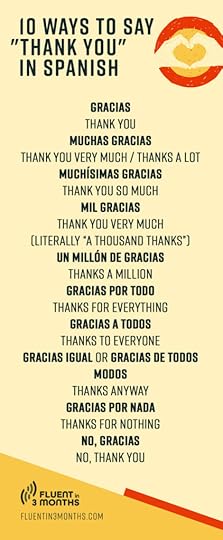 How to thank specific people
How to thank specific peopleWondering how to thank specific people, like how to say “thank you, my love” in Spanish? It’s super easy! You just identify them after gracias.
For example, “thank you, my love,” is gracias, mi amor.
Other useful phrases are:
Gracias, mi amigo or gracias, mi amiga, which mean “thank you, my friend.” (Use the former for a male friend, and the latter for a female!)Gracias, mi hermano or gracias, mi hermana means “thank you, my brother” and “thank you, my sister,” respectively. You can use this with your literal sibling or with a very close friend!Want to add a person’s name? Simple! You can just add their name at the end, like gracias María for “thanks, Maria.”
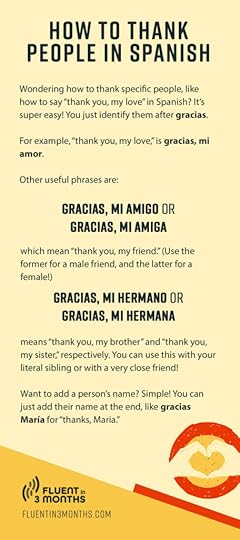 Other ways to thank in Spanish
Other ways to thank in SpanishOf course, there are many other ways to give thanks in Spanish. Here are some key words and how to use them to expand your vocabulary.
How to use agradecer – “to thank”You can use the verb “agradecer” to show your appreciation in Spanish. It literally means “to thank,” but it’s used similarly to how we would say “appreciate.” You would use this verb in somewhat formal situations.
Keep in mind that it has a slightly irregular conjugation in the yo (first person singular) form, so it turns into yo agradezco.
Now, to use it in a simple sentence, you can say either te lo agradezco or se lo agradezco for “I appreciate it” or, literally, “I thank you.” The former is when you are thanking tú, or a single person you know well and can speak casually to. The latter is for usted or ustedes, so either a single person you speak formally to or the plural “you.”
Of course, depending on what Spanish speaking region you’re in, there may still be other options. If you still have some questions about this, check out our guide on Spanish pronouns!
You can also get more creative with agradecer. For example, you can also say Te / le agradezco la ayuda, for “I appreciate your help.”
If you are beyond words, you can tell someone no puedo agradecerle lo suficiente, or “I can’t thank you enough.”
In relation, there’s also a similar adjective you can use instead of the verb. That is agradecido and agradecida, which means “thankful.” So you can say Estoy agradecido or estoy agradecida to say, “I’m thankful.” And if you’re “very” thankful, throw in a muy to make estoy muy agradecido / agradecida.
To show extreme appreciation, you can say Estoy más que agradecido / agradecida, which means, “I am beyond grateful.”
Also, like the above, if you want to say what more specifically you are thankful for, you can add por. For example, you can say estoy agradecido / agradecida por tu / su ayuda for “I am thankful for your help.”
How to use apreciar – “to appreciate”Now, I told you agradecer often translates into “appreciate” in English. Apreciar is a literal translation for “to appreciate,” but it’s just less commonly used when giving thanks compared to agradecer. Apreciar also means “to appreciate” in a sense of valuing something, like if you “appreciate” honesty in a person or “appreciate” someone’s advice. It’s a good one to learn if you’re trying to expand your vocabulary!
It’s a regular verb, but you can’t use it on its own. In other words, you need to show what you are grateful for. For example, you could say aprecio tu / su tiempo for “I appreciate your time.” You can also use it with more complex sentences, like aprecio lo que estás tratando de hacer por mí, or “I appreciate what you’re trying to do for me.”
How to use amable – “kind”Many phrases showing thanks in Spanish use the adjective “amable” or something similar. It means “nice” or “kind.” You can use it in phrases like:
Qué amable – “How kind.” You can add de tu / su parte or eres/es at the end to say, “How kind of you” and “How kind you are,” respectively.Es muy amable (de tu / su parte) – “That’s very kind of you.” This is a similar construction as the first!Eres muy amable or es muy amable – “You are very kind.” (The former is for tú. The latter is for usted)Muy amable – “Very kind [of you].” This is similar to the above, but it’s lost its meaning a bit from overuse, so now it’s kind of like a less heartfelt, throwaway “thanks.”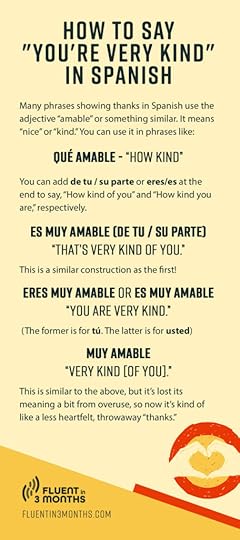
Now, there are other Spanish adjectives that also mean “kind” or “nice”. You can sometimes shake up your vocabulary with replacing amable with the following:
Atento / Atenta – “thoughtful”Bondadoso / bondadosa – “charitable”Considerado / considerada – “considerate”Cortés – “courteous”Dulce – “sweet”Generoso / generosa – “generous”Gentil – “pleasant”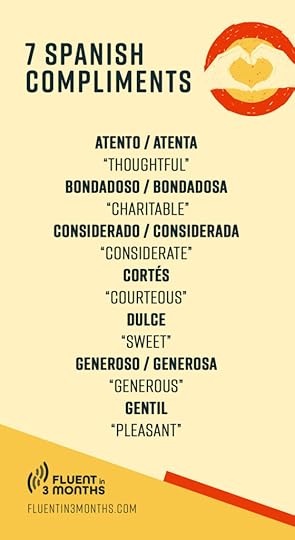
Although be careful! Gentil is often used sarcastically – like saying “how kind of you” with an eyeroll.
“Thank you for your business” in SpanishSo we already learned one way to say “thank you for your business” in Spanish. Knowing Spanish for clients is very important, so we’ll learn a few more options now!
Remember that gracias por su negocio is the basic phrase for “thank you for your business” (literally, thank you for your “business”). Depending on the situation, we can also say:
Gracias por sus compras – literally, “thank you for your purchases”Gracias por su pedido – literally, “thank you for your order”Gracias por su aportación – literally, “thank you for your contribution”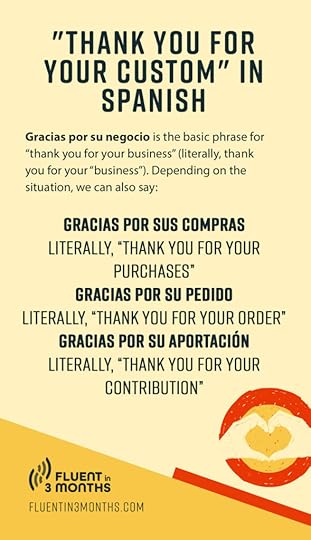
You can also use some of the verbs we learned above to thank someone for their business. For example, you can also say:
Apreciamos su negocio – “We appreciate your business”Agradecemos que haga negocios con nosotros – “We appreciate you doing business with us”The above was conjugated into the nosotros (“we”) form of a verb, but if you’re a sole trader, you can always use the yo form (aprecio and agradezco).
Gracias por: Thanks for other things in SpanishWe already have quite a list of things to be thankful for! But I know I may not have covered everything you might want to thank someone about. So to wrap up, here’s a list of other things you might want to show appreciation for using gracias.
Keep in mind that for simplicity’s sake, I’ll use the usted form of the examples here, but remember you can use them all with tú and other pronouns also!
Gracias por + nounsHere are some common phrases with gracias por with nouns:
Gracias por su apoyo – “thank you for your support”Gracias por su arduo trabajo – “thank you for your hard work”Gracias por su atención – “thank you for your attention [to an announcement]”Gracias por su ayuda – “thank you for your help”Gracias por su comprensión – “thank you for your understanding”Gracias por las felicitaciones por mi cumpleaños – “thank you for the birthday wishes”Gracias por el regalo – “thank you for the gift”Gracias por su servicio* – “thank you for your service”
I wanted to tell the chef in Madrid here, Gracias por la buena comida! (“Thank you for the good food!”)
Gracias por + verbsHere are some common phrases with gracias por with verbs:
Gracias por darme un aventón – “thanks for giving me a lift”Gracias por escribirme* – “thanks for writing”Gracias por escucharme – “thanks for listening to me”Gracias por preguntar – “thanks for asking”Gracias por ser un buen amigo / amiga – “thank you for being a good friend”Gracias por venir – “thank you for coming”Conclusion: Don’t be afraid to show your appreciation!Of course, the things we can thank people for are endless! So what are you thankful for? I hope you can express it in Spanish now! Keep learning, and keep showing appreciation for all those who help you out.
How to Say “Good Morning” in Spanish (and 88 other Useful Spanish Words and Phrases)How I Learnt Spanish, Italian and Portuguese for the Price of a Beer16 Different Ways to Say “Thank You” in FrenchJapanese project: Reach fluency in 3 months… in Spain [INTRO VIDEO]15 Ways to Say “Thank You” in PortugueseThe post How to say “Thank You” in Spanish (and 42 Other Ways to Show Your Appreciation) appeared first on Fluent in 3 Months.
January 26, 2024
How to Say Hello in Greek (And 30+ Other Greetings in Greek)
Γεια σου! (yia su!) That’s how to say “hello” in Greek!
Is it really that simple? Yes and no. While you can get away with saying Γεια σου, in most cases, your Greek conversation will likely (and hopefully!) continue after saying hello.
Plus, it’s also common to use different words to say hello depending on the time of the day.
As a long-time Greek learner and language writer, I’m going to show you all the Greek words for hello, common greeting and parting words, and other ways of saying hello!
function runSplitTest(){var randomNumber = Math.floor(Math.random() * 2) + 1console.log(randomNumber)var copy = "";if (randomNumber == 3){ copy = '<i>A note from the Fluent in 3 Months team before we get started: You can chat away in a new language for at least 15 minutes with the "Fluent in 3 Months" method. All it takes is 90 days. <a href="https://www.fluentin3months.com/other... this link to find out more.</a></i>'} else { copy = '<i>A note from the Fluent in 3 Months team before we get started: You can chat away with a native speaker for at least 15 minutes with the "Fluent in 3 Months" method. All it takes is 90 days. <a href="https://www.fluentin3months.com/other... this link to find out more.</a></i>'}var copyToChange = document.querySelector("p.copyText").innerHTML = copy;}runSplitTest();Table of contentsHow to Say Hello in GreekMore Greek Words for HelloHow to Say “How Are You?” in GreekMeeting Someone New in GreekHow to Say Welcome in GreekHow Do You Say Hello in Greek Depending on the Time of the Day?MorningNoonAfternoonNightSeasonal Greetings in GreekHow Do You Greet Someone in Greek?How to Write “Hello” in GreekHow to Say Goodbye in GreekOther Polite Phrases in GreekSay γεια to learning GreekHow to Say Hello in Greek“Hello” in Greek is Γεια (yia). You hear people saying Γεια σου (yia su) or Γεια σας (yia sas) all the time.
The difference between them is simple: you use yia su to address one person, most likely your friend, someone you know well, or someone close to your age. You say yia sas when you’re greeting a group, a person you don’t know, or someone you respect due to their age or status.
Γεια σου (yia su) Γεια σας (yia sas) Is it informal or formal? Informal Formal (when used while addressing one person) Singular or plural? Singular Both Who can I use it for?(When singular) Friends, family members. Boss, older people. More Greek Words for Hello
When greeting a friend, you also say yia su followed by their name. In a formal setting, you can say yia sas followed by Ms. or Mr. and their surname. That said, using yia su and yia sas on their own is also very common.
Here are some examples:
Γεια σου (yia su): “Hello” (informal)Γεια χαρά (yia hara): “Hi there” or “Hey” (informal)Έλα! (Ela): “Hey!” or “Yo!” (also used when picking up the phone)Γεια σας (yia sas): “Hello” (formal or plural)Χαίρετε (herete): “Hello” or “Greetings” (formal)Γεια σε όλους (yia se olus): “Hello, everyone”Γεια σας, κυρία Ανδρέου (yia sas, kiria Andreu): “Hello, Ms. Andreu”Γεια σας, κύριε Ανδρέου (yia sas, kirie Andreu): “Hello, Mr. Andreu”Γειά σου, Άννα (yia su, Anna): “Hello, Anna”Γειά σου, φίλε μου (yia su, file mu)*: “Hello, my friend”How to Say “How Are You?” in GreekA “hello” can quickly lead to a “how are you.” In some cases, people might also start the conversation by saying ti kanis (“how are you”) instead of yia sou.
There are many different ways of saying “how are you” in Greek, depending on the formality level. Here are some of the common ones:
Τι κάνεις; (Ti kanis?): “What are you doing?” or “How are you?” (informal)Τι κάνεις σήμερα; (Ti kanis simera?): “What are you doing today?”Τι γίνεται; (Ti yinete?): “What’s happening?” (informal)Έλα, τι κάνεις; (ela, ti kanis?): “Hey, how are you doing?” (informal, used between friends)Τι κάνετε; (Ti kánete?): “What are you doing?” (formal or plural)Τι κάνετε σήμερα; (Ti kanete simera?): “What are you doing today?” (formal or plural)Τι νέα; (Ti nea?): “What’s new?”Πώς είσαι; (Pos ise?): “How are you?” (informal)Πώς είστε; (Pos iste?): “How are you?” (formal or plural)Καλά είμαι, εσύ πώς είσαι; (Kala ime, esi pos ise?): “I’m fine, how are you?” (informal)Καλά είμαι, εσείς πώς είστε; (Kala ime, esis pos iste?): – “I’m fine, how are you?” (formal or plural)Πώς πάει; (Pos pai?): “How is it going?”Πώς σας πάει; (Pos sas pai?): “How is it going?” (formal or plural)Πώς περνάς; (Pos pernas?): “How are you doing?”Πώς περνά η μέρα; (Pos perna i mera?): “How is the day going?”Πώς περνά η μέρα σου; (Pos perna i mera su?): “How is your day going?” (informal)Πώς περνά η μέρα σας ; (Pos perná i méra sas?): “How is your day going?” (formal or plural)Meeting Someone New in GreekWhen you’ve just met someone new, you might want to follow up your “hello” with a “nice to meet you.” Or if you haven’t caught their name yet, you might also ask it right after saying yia su.
Πώς σε λένε; (Pos se lene?): “What is your name?” (informal)Πώς σας λένε; (Pos sas lene?): “What is your name?” (formal or plural)Ποιο είναι το όνομά σου; (Pio ine to onoma su?): “What is your name?” (informal)Ποιο είναι το όνομά σας; (Pio ine to onoma sas?): “What is your name?” (formal or plural)Από πού είσαι; (Apo pu ise?): “Where are you from?” (informal)Από πού είστε; (Apó pou iste?): “Where are you from?” (formal or plural)Με λένε… (Me lene): “My name is…” (Say me lene followed by your name.)Το όνομά μου είναι… (To onoma mu ine): “My name is…” (Say to onoma mu ine followed by your name)Χάρηκα (Ηarika): “Nice to meet you”Χαίρω πολύ (Hero poli): “Nice to meet you”How to Say Welcome in GreekImagine that you’ve invited a Greek-speaking friend over for dinner. In this case, it will be more relevant to greet them by saying “welcome” instead of “hello” as they arrive.
Καλώς ήρθες (kalos irthes): “Welcome” (informal)Καλώς ήρθατε (kalos irthate): “Welcome” (formal or plural)Χαίρομαι που είσαι εδώ (herome pu ise edo): “I’m glad to have you here” (informal)Χαίρομαι που είστε εδώ. (herome pu iste edo): “I’m glad to have you here” (formal or plural)How Do You Say Hello in Greek Depending on the Time of the Day?Like in many languages, greetings in Greek can also change depending on the time of the day. These include greetings such as “good morning” or “good evening.”
MorningKali or kalo mean “good” in Greek, and mera means “day.” Kalimera means both “hello” and “good morning.” Most people use it to say hello during the day, before 12 p.m.
Καλημέρα (kalimera): “Good morning”Καλημέρα σας (kalimera sas): “Good morning everyone”NoonMesimeri is noon or lunchtime in Greek. During mesimeri, some people take a nap, while others go out for lunch. Although not all, some shops in Greece might close between 1pm and 4:30 p.m.
Καλό μεσημέρι (Kalo mesimeri): “Good noon/good afternoon”Καλή όρεξη (kali oreksi): “Enjoy your meal”AfternoonKalispera comes from the combination of kali and espera, which means afternoon. After lunchtime, you can start saying kalispera instead of kalimera. Another word that means afternoon in Greek is apogevma.
Καλησπέρα (kalispera): “Good afternoon”Καλησπέρα σας (kalispera sas): “Good afternoon everyone”Καλό απόγευμα (kalo apogevma): “Have a good afternoon”Night“Good night” in Greek is kalo vradi or kalinihta. These words are rarely used as a greeting — instead, you say kalo vradi or kalinihta as you leave a venue or go to bed. If you want to say hello to someone at night, you can use yia su or kalispera.
Καλό βράδυ (Kalo vradi): “Good night”Καληνύχτα (kalinihta): “Good night”Καλησπέρα (kalispera): “Good evening”Seasonal Greetings in GreekSpending Christmas in Greece? Or Easter in Cyprus? Besides making yourself familiar with local traditions, you can also learn some festive greetings.
Καλά Χριστούγεννα (Kala Christuyenna): “Merry Christmas”Ευτυχισμένο το Νέο Έτος (Eftihismeno to Neo Etos): “Happy New Year!”Καλό Πάσχα! (Kalo Pasha): “Happy Easter”Χρόνια Πολλά (Hronia Polla): – “Happy Name Day” or “Happy Birthday”Καλό καλοκαίρι (Kalo kalokeri): “Have a good summer”Καλές γιορτές (Kales yiortes): “Happy holidays”How Do You Greet Someone in Greek?You can greet someone in Greek by saying yia su or yia sas.* Alternatively, you can also say kalimera or kalispera depending on the time of the day. Friends often give each other a hug or a kiss on each cheek.
For people who have just met, it’s more appropriate to shake hands and use formal language, especially if they’re older. For example, instead of yia su it will be yia sas, or instead of pos ise (“how are you”), it will be pos iste.
How to Write “Hello” in GreekSince the Greek alphabet is different from the Latin alphabet, learning how to read and write might take some time. To write the word “hello” for example, you use four letters:
Γ (Γάμμα): “Gamma”Ε (Έψιλον): “Epsilon”Ι (Ήτα): “Iota”Α (Άλφα): “Alpha”In block capitals, it’s ΓΕΙΑ. In lowercase, it would be γεια, with the letter “gamma” slightly different from its capital letter version. If you add σας (sas) to the end, your γεια becomes formal or plural. If you add σου (sou), it becomes informal. That said, it’s also fine to use γεια on its own.
The block capital version of sas is ΣΑΣ, and for sou it’s ΣΟΥ.
How to Say Goodbye in GreekEvery hello has a goodbye. As we near the end of this article, let’s learn some words that mean goodbye in Greek.
Αντίο (Adio): “Goodbye”Τα λέμε (Ta leme): “See you”Να προσέχεις (na prosehis): “Take care”Καλό ταξίδι (Kalo taksidi): “Have a good journey”Πρέπει να φύγω (Prepi na figo): “I’ve got to go”Καλή συνέχεια (kali sinerhia): “Enjoy the rest of your day”Καληνύχτα (kalinihta): “Good night”Όνειρα γλυκά (onira glika): “Sweet dreams”Other Polite Phrases in GreekIn addition to greetings, it is important to know about some polite expressions, especially in formal settings.
Παρακαλώ (parakalo): “Please”Ευχαριστώ (efharisto): “Thank you”Ευχαριστώ πολύ (Efharisto poli): “Thank you very much”Συγγνώμη (signomi): “Excuse me”Παρακαλώ πολύ (parakalo poli): “You’re very welcome”Say γεια to learning GreekSaying hello in a different language is often the first step of learning.
Now that you know how to say hello in Greek, it’s time to browse more resources to improve your Greek, be it vocabulary, grammar, pronunciation, or conjugation.
Learn Greek Online: 39 Free Resources and Classes to Learn the Greek Language40+ Cool Greek Words That Will Make You Want to Learn GreekTagalog: a fun language to learn in the Philippines!Black Friday Deals for Greek Language Courses28 Synonyms for Love from Around the World (+ Literal Translations into English)The post How to Say Hello in Greek (And 30+ Other Greetings in Greek) appeared first on Fluent in 3 Months.
January 19, 2024
How to Tell the Time in Spanish (Complete Guide)
Ever wonder how to tell the time in Spanish? This is super important because Spanish-speaking cultures often operate on very different schedules than the rest of the world – think taking a long siesta over lunch break and dinner starting at 9 or 10 pm!
So make no assumptions about time in Spanish-speaking countries. Before you do anything, make sure you clearly understand what time things happent. Luckily, I’m here to help you as both your language and cultural guide.
In this article, I’ll teach you the following phrases and more:
¿Qué hora es? (“What time is it?”)Es/Son… (“It’s … o’clock.”)Es la una y media. (“It’s 1:30.”)Son las diez de la mañana. (“It’s 10:00 am.”)Son las ocho de la noche. (“It’s 8:00 pm.”)Como a la una. (“I eat at 1:00.”)¿A qué hora te acuestas? (“What time do you go to bed?”)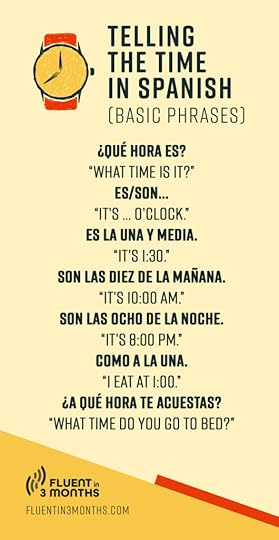
And just a quick bit about me before we get stuck in: I’m a globe-trotting American who has spent most of my adult life overseas. I’m a language teacher and writer, and I’ve spent over 5 years studying Spanish.
Let’s get started!
function runSplitTest(){ var randomNumber = Math.floor(Math.random() * 4) + 1; console.log(randomNumber); var copy = ""; if (randomNumber == 1){ copy = '<i>A note from the Fluent in 3 Months team before we get started: You can chat away in Spanish for at least 15 minutes with the "Fluent in 3 Months" method. All it takes is 90 days. <b><a href="https://www.fluentin3months.com/bootc... this link to find out more.</b></a></i>'; } else if (randomNumber == 2) { copy = '<i>Before we get started, if you’re looking for an online Spanish course, here’s the course I recommend: <a href="https://www.fluentin3months.com/olly-... Uncovered - Learn Spanish Through the Power of Story</b></a>, a course with a fascinating new method by my friend Olly. You can try it for free for 7 days!</i>'; } else if (randomNumber == 3){ copy = '<i>Expand your horizons and learn a new language with our 90-Day Personalized Language Course. Backed by research, our coaching will get you expert results. <b><a href="https://www.fluentin3months.com/bootc... this link to find out more.</b></a></i>'; } else { copy = '<i>Ready to be fluent in just 3 months? Our Research Backed Language Coaching guarantees better results. Sign up now for our 90-Day Personalized Language Course. <b><a href="https://www.fluentin3months.com/bootc... this link to find out more.</b></a></i>' } console.log(copy); var copyToChange = document.querySelector("p.copyText").innerHTML = copy;}runSplitTest();Table of contentsThe Basics of Telling Time in Spanish: What to Know FirstHow to Ask and Answer “What Time Is It?” in SpanishHow to Answer ¿Qué Hora Es? : “What Time Is It?”Specific Times and Time Expressions in SpanishSaying When Things Happen in SpanishWhy, When, and How to Use the 24-Hour Clock in SpanishUnderstanding Ser and the Grammar in Spanish TimeSpanish Time and Cultural DifferencesPunctuality is Somewhat RelaxedMeal Times Start LaterTelling Spanish Time Like a Pro!The Basics of Telling Time in Spanish: What to Know FirstFirst, let’s do a little prep so we can say the time in Spanish like a pro.
If you know how to count from 1 to 59, you’ll be able to master how to say the time in Spanish. (And if you haven’t done so yet, check out our article all about counting in Spanish!) But if you’re not quite there yet, you can say a lot by just learning 1 through 12 for now.
We will also be using the verb “to be” (ser) in Spanish. We have more details about it in our article about Spanish irregular verbs, but what you need to know is this: in the present tense, we’ll use es (“[it] is”) and son (“[they] are”). Why? I’ll explain that next!
How to Ask and Answer “What Time Is It?” in SpanishThe most common way to ask for the time in Spanish is by asking ¿Qué hora es?, which means, “What time is it?” Simple! Now let’s look at how to answer this question.
How to Answer ¿Qué Hora Es?: “What Time Is It?”Now, to answer “What time is it” in Spanish, we will start our sentence with either es or son. How do you know which one to use?
Easy! If it’s in the one o’clock range, you use the singular es. If it’s two o’clock or later, you use the plural son.
Then we add la (in the case of “one o’clock”) or las (for “two o’clock or later) plus the number.
So in other words:
“It’s one o’clock” = Es la una.“It’s two o’clock” = Son las dos.“It’s three o’clock” = Son las tres.“It’s four o’clock” = Son las cuatro.“It’s five o’clock” = Son las cinco.“It’s six o’clock” = Son las seis.“It’s seven o’clock” = Son las siete.“It’s eight o’clock” = Son las ocho.“It’s nine o’clock” = Son las nueve.“It’s ten o’clock” = Son las diez.“It’s eleven o’clock” = Son las once.“It’s twelve o’clock” = Son las doce.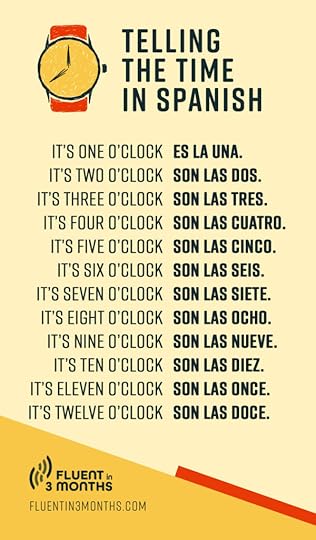
Now, Spanish doesn’t have an “am” and “pm” system. Instead, it specifies the time of day with the following four phrases:
de la mañana = “in the morning.” This technically is for any time before noon, but is often used for any time before lunch (which might be a bit later).de la tarde = “in the afternoon.” Use this for times in the afternoon but before nightfall, approximately between 12:00 pm to 6:00 pm.de la noche = “at night.” Use this for most times in the evening or night, approximately between 6:00 pm to 12:00 am. (Note that what constitutes noche vs. tarde may vary across regions and cultural contexts.)de la madrugada = “in the middle of the night.” We don’t have this exact expression in English, but it’s for the small hours very late at night or very early in the morning. (Useful if you go partying or clubbing, or else if you want to yell at someone for calling you at 2:00 am!)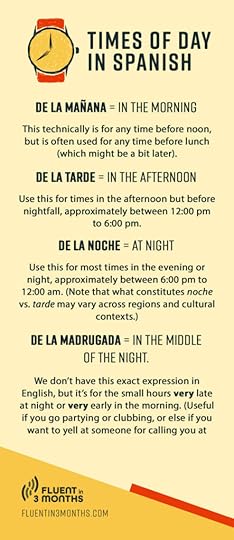
So for example, to say “It’s ten o’clock am,” you would say Son las diez de la mañana. On the other hand, to say “It’s eight o’clock pm,” you would say Son las ocho de la noche. And if your ex calls you to tell you they miss you at one am? ¡Es la una de la madrugada!
By the way, Spanish also has words for “noon” or “midday” (mediodía) and “midnight” (medianoche).
Note that sometimes Spanish uses the 24-hour clock – or if you’re American like me, you might know this as “military time.” So on occasion, you’ll hear or see things like “thirteen o’clock.” This follows the same pattern as the above. We’ll put a pin in this for now but don’t worry. I’ll go into more detail about this in just a bit.
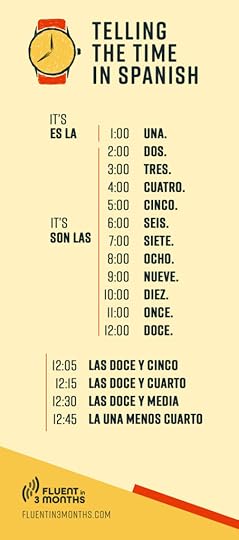 Specific Times and Time Expressions in Spanish
Specific Times and Time Expressions in SpanishOkay, so we’ve covered the basic hours, but how do you say specific times in Spanish? After all, time isn’t always spot on the hour!
This is easy! To indicate minutes, just add y and the number of minutes.
For example, 6:05 would be las seis y cinco. 12:36 would be las doce y treinta y seis.
Note that some people may replace y (“and”) with con (“with”) or completely omit this word! So 9:10 could be las nueve y diez or las nueve con diez, or las nueve diez. This may depend on the dialect of Spanish being spoken or personal preference. But using y is the most widely understood and used version of this sentence.
Now, when the time hits 15-minute increments, things often change a bit:
If it’s a “quarter past” the hour (in other words, 15 minutes past), use the phrase y cuarto. This means “and a quarter.” So 4:15 would be las cuatro y cuarto. (I know, it’s a bit of a tongue twister!)If it’s “half past” the hour (in other words, 30 minutes past) use the phrase y media. This means “and half.” So 1:30 would be la una y media.If it’s “quarter till” the next hour (in other words, 45 minutes past), use the upcoming hour and add menos cuarto (“minus a quarter”). So 6:45 would be las siete menos cuarto (7:00 minus a quarter).Now, it is possible to use the time y quince (:15), y treinta (:30), and y cuarenta y cinco (__:45). Using y media is especially common, but which system you use may depend on personal and regional references, just like as in English.
Also, you can use menos flexibly with other expressions, too. For example, for 9:55, you can say las diez menos cinco.
By the way, here are a couple more useful phrases to be more specific about the time:
en punto = “exactly,” “on the dot,” or “sharp” (Son las tres en punto = “It’s 3:00 exactly.”)más o menos = “more or less,” “about” (Es la una y cuarto, más o menos = “It’s about 1:15.”)y pico = “just after” or “just past” (Son las once y pico = “It’s just after 11:00.”) Note this is a very colloquial phrase.Saying When Things Happen in SpanishOkay, so we’ve covered how to read the clock. And so what about when you want to talk about what time certain things happen? For example, how do you say, “I eat at 1:00”?
In this case, just add a (“at”) and the time with the article la or las. So in this sentence, you would say, Como a la una.

Here’s an example of a big lunch you might eat in Spain!
This goes for questions as well. To ask, “What time do you go to bed?”, you would use ¿A qué hora te acuestas? (informal) or ¿A qué hora se acuesta? (formal). This translates literally into “At what time do you go to bed?”
Now, to talk about whether something happens in the am or pm, we can use the same four phrases above. But you’ll often hear Spanish speakers replace de with por. Why? Let me explain.
For example, if you’re on the night shift, to say, “We work at 3:00 am,” you could say either Trabajamos a las tres de la madrugada or Trabajamos a las tres por la madrugada. There is just a subtle difference in meaning. de emphasizes the exact time, while por implies a duration. So the former sentence is exact about the time (probably implying that work starts at 3:00 am), while the latter emphasizes the duration extending into 3:00 am.
Why, When, and How to Use the 24-Hour Clock in SpanishAs I mentioned, sometimes Spanish uses the 24-hour clock, and this is more often used when you write time in Spanish. You’ll see this in written or formal Spanish, such as in official documents, schedules, and timetables.
For example, Spanish might use this method when making announcements on public transportation or declaring event times. This may feel foreign to our readers from the United States but perhaps more familiar to any British or European readers.
Of course in spoken Spanish, we’ll use the 12-hour clock most commonly. But it is still possible to say the time using the 24-hour system. Therefore, it would go a little something like this:
“It’s thirteen o’clock” = Son las trece. (13:00 = 1:00 pm)“It’s fourteen o’clock” = Son las catorce. (14:00 = 2:00 pm)“It’s fifteen o’clock” = Son las quince. (15:00 = 3:00 pm)“It’s sixteen o’clock” = Son las dieciséis. (16:00 = 4:00 pm)“It’s seventeen o’clock” = Son las diecisiete. (17:00 = 5:00 pm)“It’s eighteen o’clock” = Son las dieciocho. (18:00 = 6:00 pm)“It’s nineteen o’clock” = Son las diecinueve. (19:00 = 7:00 pm)“It’s twenty o’clock” = Son las veinte. (20:00 = 8:00 pm)“It’s twenty-one o’clock” = Son las veintiuno. (21:00 = 9:00 pm)“It’s twenty-two o’clock” = Son las veintidós. (22:00 = 10:00 pm)“It’s twenty-three o’clock” = Son las veintitrés. (23:00 = 11:00 pm)“It’s twenty-four o’clock” = Son las veinticuatro. (24:00 = 12:00 am)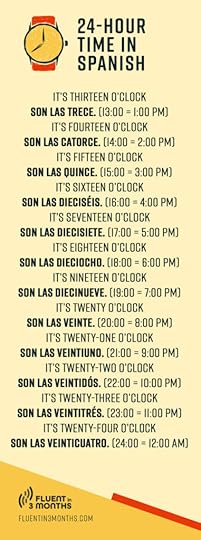
For example, when you look at the timetable to book a train from Madrid to Toledo (a wonderful day trip, by the way!) on Renfe, you’ll notice they use the 24-hour clock!

So when you buy your Spanish train ticket, make sure you’re careful. If not, you might accidentally end up at the station thinking you leave at 3:00 instead of 13:00!
Understanding Ser and the Grammar in Spanish TimeThere are two things worth noticing about ser when using telling time in Spanish. And understanding these grammar points will push your Spanish comprehension up to the next level!
First, keep in mind that when you ask, “What time is it?” you don’t use the plural form of the verb ser. This is true even if you know it’s two o’clock or later. This is because ¿Qué hora es? literally means “What hour is it?” (It would sound silly to ask “What hours are they?” even in English!)
Second, if you’re at the level where you’re learning about the differences between ser and estar, you may be wondering why we don’t use estar. “Wait a minute, isn’t ser used for permanent things, and estar for temporary things? Why don’t we use estar since the time changes constantly?”
It’s a great question! Even though Spanish doesn’t usually use estar with permanent states, time is the exception. Possibly, Spanish speakers view time as a permanent and continuous state. In any case, it’s a linguistic convention that has been in place for a long time.
But don’t worry too much about this. We have a great acronym (DOCTOR, anyone?) to help you remember this in our article all about when to use ser and estar! If you’re ready for it, definitely check it out!
Spanish Time and Cultural DifferencesHispanic culture is famous for its perception of time compared to many Anglophone cultures! Here are a few key differences, although there might be some variance depending on whether you’re in an urban or rural area.
Punctuality is Somewhat RelaxedIn the US and UK for example, punctuality is valued. Being on time shows respect for the other person’s time. However, in many Spanish-speaking cultures, this doesn’t always hold true. Being “on time” is more flexible. The idea of sticking to planned schedules for utmost management efficiency isn’t as attractive. It’s not uncommon for events and meetings to start later than the scheduled time.
But be careful – this is usually true when people are meeting each other. If you have a train to catch, make sure you’re on time!
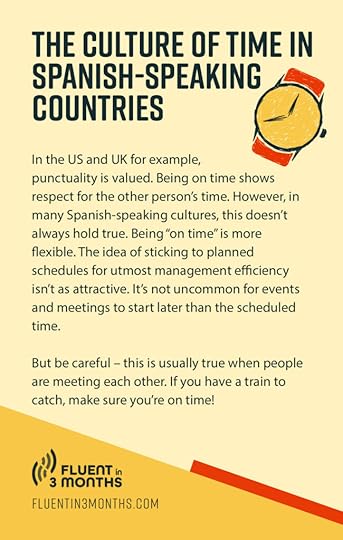 Meal Times Start Later
Meal Times Start LaterIn many Spanish-speaking countries, meals – especially dinner – often start later than in the US and UK. It’s not uncommon for dinner to start anywhere between 8:00 to 10:00 pm in Hispanic culture! However, lunch is usually the biggest meal in these cultures, so dinner is much lighter than in many English-speaking countries.
I just met someone from Argentina who told me she doesn’t send her kids to bed until midnight – probably because they don’t eat dinner until 10:00 pm!
Lunch is also often relatively late, often starting between 1:00 to 3:00 pm. This is also connected to siesta culture, in which businesses might close for a few hours after lunch. Employees often take long lunches (compared to the 30 or 60 minutes common in US culture).
This can be seen as a blessing or a curse. While taking a couple of hours to digest a long lunch might be great for some people, a Spanish friend I met in Spain felt burdened by this. Since most businesses were also closed at this time, he couldn’t do any errands, and since lunches ran late, the end of working hours did too!
Telling Spanish Time Like a Pro!Now that you know all the ins and outs of telling time in Spanish, you’ll never get confused again! With just a few common words, you can talk about all sorts of times and make all sorts of plans. So have fun, and hasta luego (see you later)!
The post How to Tell the Time in Spanish (Complete Guide) appeared first on Fluent in 3 Months.
January 12, 2024
Vietnamese Culture: The Beautiful Traditions Your History Textbooks Never Taught You
There’s lots to celebrate about Vietnam and Vietnamese culture. But if you’re like me, the first time you heard the word Vietnam, it had less to do with the country itself and more to do with politics and war.
Behind the veils of what has been portrayed about Vietnam in films, media, and books, you’ll find the same thing in Vietnamese culture that you’ll find in any country: people, culture, food, and traditions.
function runSplitTest(){var randomNumber = Math.floor(Math.random() * 2) + 1console.log(randomNumber)var copy = "";if (randomNumber == 3){ copy = '<i>A note from the Fluent in 3 Months team before we get started: You can chat away in a new language for at least 15 minutes with the "Fluent in 3 Months" method. All it takes is 90 days. <a href="https://www.fluentin3months.com/other... this link to find out more.</a></i>'} else { copy = '<i>A note from the Fluent in 3 Months team before we get started: You can chat away with a native speaker for at least 15 minutes with the "Fluent in 3 Months" method. All it takes is 90 days. <a href="https://www.fluentin3months.com/other... this link to find out more.</a></i>'}var copyToChange = document.querySelector("p.copyText").innerHTML = copy;}runSplitTest();Table of contentsCelebrating Vietnam Beyond War and PoliticsWhy An American Chose To Live In VietnamFood & Family Life In VietnamConfucianism In VietnamCelebrating Vietnam Beyond War and PoliticsWhat follows is not necessarily the facts you’ll find in history textbooks. It’s my attempt to celebrate the rich culture that Vietnam has to offer, all whilst not overlooking the bizarre components that may have you scratching your head in disbelief.
This account is based on my personal experience, having spent 6 years living and traveling in Vietnam, and nearly a decade living with a Vietnamese partner.
Am I biased? Sure, but not in the ways you may think. Like any group of people, Vietnamese culture has its pros and cons. Often, Vietnamese people will ask me, “Bạn có thích sống ở Việt Nam không?”
“Do you like living in Vietnam?”
My reply is always the same.
“Không thích thì đã không ở đây rồi!
“If I didn’t like it, I wouldn’t stay [here]!”
 Why An American Chose To Live In Vietnam
Why An American Chose To Live In VietnamWhen I graduated from university in 2013, I was eager to travel the world. Young and adventurous, I yearned to visit the most unique and exotic parts of the globe.
When it came to places to explore, my list came down to Latin America, Africa, and South East Asia.
I chose South East Asia since it was the only place I’d never been to. I chose Vietnam because I knew there was a huge curiosity about it.
At the time, I had a dream to have my own travel TV show. My plan was this: learn Vietnamese and immerse myself in the culture so I could learn as much as possible and become the “expert” on Vietnam. Then, one day CNN or BBC would call me and ask me to be the host of their new travel TV show.
Well, life had other plans for me. I never got my own travel TV show, but I managed to get on several Vietnamese TV programs, find a Vietnamese partner, and pick up the language. Here I am, almost a decade later, and I’m excited to share what I’ve learned about this wonderful and exotic country.
 Vietnamese Values: War and Moving On
Vietnamese Values: War and Moving On“Are Vietnamese people bitter towards Americans?” is perhaps the most common question I get asked when I tell Americans that I live in Vietnam. It’s a valid question, so we’ll tackle it right off the bat: No, Vietnamese people don’t feel bitterness towards Americans or America because of the war.
Now, I can’t vouch for all 100 million Vietnamese citizens, but I’ve personally never had anyone show signs of bitterness towards me that is anyhow related to the war. In general, Vietnamese people seem to be very stoic about the past.
For example, my father-in-law is a member of the communist party and also served in the war. As far as I know, he’s never spoken to his family about the war. Not once.
When I asked him about it, he said, “Oh, that’s the past, no need to talk about it.”
“But do you feel angry about Americans?” I pressed.
“No,” he replied. “War is war.”
10 months after moving to Vietnam, I had another emotional encounter with a war veteran deep in the mountains of North West Vietnam.
I was visiting a remote Hmong ethnic group and I happened to find myself alone with a middle-aged man, drinking tea inside his humble home. On the wall hung photos of his family, so I began to ask about them.
He pointed to his wife and children and shared their names.
“Do you have any siblings?” I asked.
“Yes,” he replied. “All of them died in the war.”
My heart sank and I became overflooded with guilt.
“The American war?” I asked.
“Yes,” he responded.
He was calm, I was the one who could barely hold back my tears.
“And your parents?” I asked.
“Also dead. The War. Everyone died. Except me.”
I froze. Part of me suddenly started to fear for my life. Another part of me wanted to erupt into tears. He looked so relaxed and calm, I didn’t sense any anger coming from him. Hiding my tears, I summoned another question.
“Do you hate America?”
“No,” he replied earnestly. “War is war.”
 How Vietnamese People Deal With The Past
How Vietnamese People Deal With The PastThis story beautifully illustrates how Vietnamese people seem to think about war and the past. “War is war. The past is the past. What’s the point in holding onto anger? Let’s move on.”
If a Vietnamese person wanted to hold a grudge against any nation, it wouldn’t be America. Sure, America was rather disruptive for some time, but so were the Japanese and also the French. Still, Vietnamese people seem to be more grateful for the influences these nations left behind.
Before colonialism, Vietnam was under Chinese rule for over 1,000 years. Most Vietnamese people care more about that. If Vietnam were an elementary school of students, America was an annoying substitute teacher, while China was the dominating principal.
In short, Vietnamese people are quick to forget about the past and move on. So let’s take a page out of their book and move on to the more colorful aspects of Vietnamese culture, starting with the topic that may make your mouth water.
 Vietnamese Food: Phở, Bánh Mì, & Beyond
Vietnamese Food: Phở, Bánh Mì, & BeyondMy wife, being the proud Vietnamese person that she is, is rather firm in her belief that Vietnamese cuisine is the best in the world. I confess I have had a hard time proving her wrong.
Vietnamese food seems to continue to blow up all over the world, and I’m not the slightest bit surprised. Not only is Vietnamese food delicious, but it’s also much healthier than most other cuisines. Most meals consist of a nice balance between protein, starch, and vegetables.
Vietnamese dishes are rarely deep fried and are often stir fried instead. Main dishes are almost always served with rice and veggies, so the oily dishes never dominate the meal.
But Vietnamese food is not perfectly healthy. Most dishes and sauces include a high amount of refined sugar. On top of that, MSG, an artificial flavor enhancer, is also a common ingredient in many dishes. For these two reasons, there are very few traditional Vietnamese restaurants I dine at.
I believe the most important thing to note about Vietnamese cuisine is the freshness. This is why my wife and I have never walked out of a Vietnamese restaurant in the USA satisfied: the food isn’t nearly as fresh.
Even the cheapest street food vendors go to the market every morning to get their ingredients fresh. They know that if they don’t, customers won’t come back.
True story, it took me over 5 years to convince my wife that it’s okay to eat leftovers! Many Vietnamese housewives go to the market every morning, and some even go more than once a day. Vietnamese people value freshness way more than nutritional value.
 The Variety of 3,000 Vietnamese Dishes
The Variety of 3,000 Vietnamese DishesThe variety of Vietnamese dishes seems to be endless. I once heard a story about an ancient Vietnamese king who was so obsessed with novelty and food that his chef was never allowed to serve the same dish twice.
I’m not sure if this tale is true, but Google suggests that there are over 3,000 different Vietnamese dishes, and I wouldn’t be surprised if that’s a low estimate.
It seems to me that no matter your starting point if you were to drive 30 minutes in any direction, you’re bound to stumble upon a new local dish that can’t be found in any other part of the country. It’s pretty fascinating.
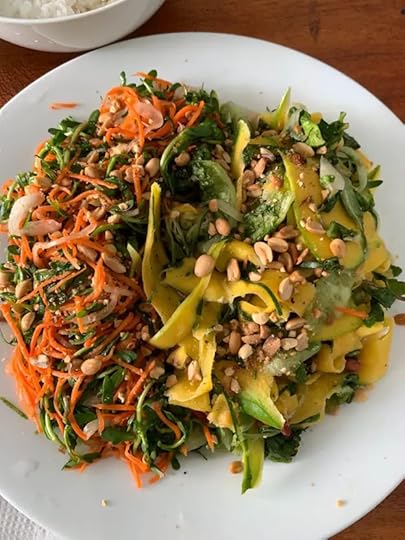 Traditional Vietnamese Medicine & Food
Traditional Vietnamese Medicine & FoodOne fascinating thing I recently learned is that according to Vietnamese traditional medicine, every food has an energetic impact on the stomach that lies on the scale of yin (cooling) and yang (heating).
Some foods are neutral, but all foods lie somewhere on the spectrum. This stems from Traditional Chinese Medicine. This balance is good for digestion and helps maintain a light stomach and comfortable body. It also prevents indigestion and heaviness.
So, Vietnamese dishes aren’t just optimized solely for taste and nutrition, they also maintain a yin-yang balance. This is especially the case for traditional dishes that have been passed on for many generations.
For example, duck meat is cooling to the body, so it is eaten with ginger fish sauce, which is heating.
Most of my Vietnamese friends know whether a food is yin or yang intuitively, and it’s not until I question them do they put a label on it. I find this utterly fascinating. When I hold this philosophy up against 99% of the meals I grew up eating in America, the dishes are… you guessed it, extremely unbalanced when examined through this system.
Food & Family Life In VietnamIn Vietnam, all meals are eaten as a family and shared family style. In lieu of a prayer or a “bon appetit”, it is customary for the youngest member of the family to “invite” the elders when the meal begins. Thus, the youngest will address each family member individually and say “I invite you” xin mời. They start with the oldest person and then go from oldest to youngest. But when it comes to the younger ones, they do not invite them to eat, instead they just say “Eat!”, em ăn đi!.
I appreciate the sentiment of this tradition when done with presence. However, in most cases, the elder who is being invited by the child doesn’t really acknowledge the invitation and digs right into the food. It’s as if I were to bow and say, “Father, I invite you to this meal” and then he just chews and says, “Yeah… whatever…”
If you ever want to impress a Vietnamese host, say con/em mời cả nhà “I invite the entire family” just as the meal is beginning. Also, the younger ones at the table show respect by waiting for the elders to eat first. No one starts to before the oldest person is holding their chopsticks and starts grabbing dishes.
Also, while Koreans often use metal chopsticks, Vietnamese people only use chopsticks made from coconut, bamboo, and wood.
Rice & Greetings In Vietnamese CultureRice is by far the most common food eaten in Vietnam. In fact, I’ve yet to encounter another Asian culture that loves rice as much as Vietnamese people.
Rice is usually served for lunch and dinner, breakfast often being soup or a bánh mì sandwich. Rice is also one of the most common words you’ll hear in everyday greetings.
People in Vietnam rarely ask how you are doing or how you are feeling. The two most common questions you’ll hear are ăn cơm chưa?, “Have you eaten rice yet?” and Đi đâu? “Where are you going?”.
In general, if you are in motion, they’ll ask the latter. If you’re stationary, they’ll ask the former.
In this context, rice represents any meal. If I just ate a pizza, I would respond by saying dạ, ăn rồi “yes, [I have] eaten already.”
Sticky rice is used for special occasions/celebrations/ making traditional “cakes” while normal rice is for every day. Sticky rice is heavier on the stomach (longer to digest) and hot for the body. Vietnamese don’t eat sticky rice too often, as it is said to cause acne or hinder the healing process for certain wounds.
Confucianism In VietnamVietnam has been heavily influenced by Confucianism, which means much of the culture is based on family ties, social status, and the concept of “face.”
Because social status and harmony are so crucial to Vietnamese society, your “face” – or how others see you – matters a great deal. “Saving face” means working to keep a positive reputation while staying in line with societal standards. This holds true at work, in your personal life, relationships, and everything. It can often mean compromising the truth or blatantly telling a white lie in order to save your reputation.
The strict gender roles advocated by Confucianism are also still embedded in Vietnamese culture. According to Confucianism, a woman’s duty was to her husband, wifely responsibilities, family duties, and household chores. But it doesn’t stop there. A woman’s duty is to serve three different male figures her entire life. First, her father, then her husband, and finally her son(s).
Because of these deeply embedded beliefs and cultural expectations, it is very rare for a Vietnamese man to marry a non-Vietnamese woman. On the other hand, it is very common for a Vietnamese woman, especially those interested in the feminist movement, to marry a non-Vietnamese (or Western) man.
From a Western perspective, it may appear that Vietnamese women are seen more as employees. But like many other Asian cultures, love is often associated with sacrifice.
In general, Vietnamese people believe that the more one sacrifices, the more loving they are being. The Vietnamese word for “duty” is nhiệm vụ, which translates to “responsibility” + “service”. So while it may appear to one person as a heavy obligation, the duty to one’s family is also seen as an act of service.
Also, if a parent sacrifices their own needs and desires in order to provide opportunities for the child (which is very common here), it is seen as the greatest act of love. Because of this, most kids are conditioned to feel eternally grateful and indebted to their parents.
Vietnamese Culture & Expressions Of LoveIt’s nearly unthinkable to say “I love you” to a family member in Vietnamese culture. Most people have gone their entire lives without saying it from their children or hearing it from their parents. Hugging is also very uncommon, and more likely to occur with friends rather than family.
In Vietnam, love is expressed more through actions and deeds: providing financial support, doing laundry, cooking, etc. Children are expected to show that they love their parents by being respectful/obedient, performing well in school, and staying out of trouble. Parents show their love by feeding their children, providing opportunities, and being there whenever they need help. There’s still a lot of love within the family structure, but it’s rarely expressed through words or physical intimacy.
Directness in Vietnamese CultureIt won’t take you more than a few days of being in Vietnam to be asked some very personal questions. Aside from the basic questions: “Have you eaten yet?” and “Where are you going?”, Vietnamese people tend to ask questions that are considered inappropriate or rude in the West.
For example, Vietnamese people will ask you early in a conversation how old you are. This is done for a very good reason. Embedded in the Vietnamese language is a hierarchy, and if the person you are talking to doesn’t know your age, they won’t know how to address you using the proper pronoun.
Because of this, Vietnamese people seem to hold very little insecurities about their age. If anything, they actually want people to know how old they are, as it demands more respect. In general, the older they are, the more proud they become. Those who are hesitant to share their exact age do so because they are embarrassed by how young they are.
But the personal questions don’t stop at age. It’s common for people to ask you if you own or rent your home, and how much you pay for rent, and some will even ask you how much your monthly income is. They’ll also ask you if you have a husband/wife yet. Then, they will try to hurry you into getting married and having babies by making comments or jokes.
Vietnamese Culture: Family Values And ChildrenPersonally, most of the above questions don’t faze me anymore, but there is one that I still feel uncomfortable answering: “Why don’t you have kids yet?”
Actually, let me clarify. The question that comes first is “Do you have kids yet?” Có con chưa?.
They’re not asking “Do you have kids?” it’s “Do you have kids yet?”
When I say no, most can hardly believe it. It’s like showing them I have 11 fingers. At this point, they stop asking me questions and begin to make demands.
They advise me to go and make a baby and tell me all about how much fun kids are and that the only way to be happy is to have children. In traditional Vietnamese culture, you’re not fully recognised as an acceptable woman/human being until you bear children. So, the thought of not wanting children is unfathomable to most Vietnamese people.
Vietnamese Holidays & CelebrationsThe biggest holiday, by a long shot, is Tết, the Chinese New Year. It’s basically Thanksgiving, Christmas, and New Year’s, all combined into one. It’s really the only holiday where one is expected to return to their hometown and visit family.
Traditions around Tết include a massive spring cleaning of the house. Families also visit the cemetery in order to clean up the tombstones of their ancestors as well as make their offerings.
Vietnamese people believe that ancestors (their spirits) will come back home and enjoy Tet with their living family members. So, the daughters-in-law (women in the house) will have to prepare 3 trays of offering meals in the 1st 3 days of the new year to offer to the returning spirits.
One of the traditional foods around this time is called bánh tét. It is typically cooked over a wooden fire for 12 hours straight. This invites families to stay up late hanging out around the fire.
Gifts are not typically given for this holiday, but money is. It’s called “lucky money”, and it’s given only by elders to the young ones who have yet to get jobs and therefore don’t have their own money.
Families typically enjoy one or more large meals together to celebrate. Then, in the days following the New Year, it’s common to visit friends and family and wish them a happy new year.
Besides Tết, there are also rituals that take place twice a month according to the lunar calendar on the new moon mùng một, as well as the full moon, ngày rằm.
For this, an altar is set up filled with food, fruit, incense, and decorations. Then, prayers and offerings are made to the ancestors in the spirit world. The custom is to light the insights and then bow three times before placing them on the altar. It’s also common for Vietnamese Buddhists to eat vegan or vegetarian for the day of these moon celebrations.
Vietnamese Spiritual Beliefs & Honoring Their AncestorsVietnamese people believe that their ancestors are still able to enjoy whatever offerings are placed on the altar. So, you’ll often see beer and cigarettes on altars if that’s what they think their dead relatives would want. If there’s ever an altar made in my honor, I hope they put durian fruit on it!
They also believe that by burning something, it’s able to transcend dimensions and deliver these goods to their relatives who have passed away. So, often they will burn paper money as a way to give money to their dead relatives.
[Side note: I’m not sure what use of paper money is to spirits living in another realm. If there is life after death, I really hope it doesn’t include taxes! That being said, I know that this act is done with good intentions and a way of expressing love and respect to their ancestors. And if what the Vietnamese believe is true, their dead ancestors are probably way wealthier than mine.]
Birthdays were not celebrated until very recently. My in-laws don’t even know their exact birthdate, and my wife never celebrated her birthday until she was 23. Some celebrate the first birthday called a thôi nôi, when the baby no longer using the cradle. The child may receive gifts and clothes on this occasion.
A lot of elderly people don’t know their birthdays either, and some don’t even remember the exact year they were born. It’s not that they forgot, they just never needed to know the exact date.
Anniversaries are also not celebrated in Vietnam, only by a small percentage of the young generation. I’ve noticed that personal celebrations aren’t very common in Vietnam. Graduations, birthdays, anniversaries, etc. are not highlighted as much as they are in the West. I believe this because in Vietnamese culture, there isn’t a strong value placed on the individual.
 Vietnamese Customs & Cultural Values
Vietnamese Customs & Cultural ValuesThere are lots of unique Vietnamese customs that are quite different from Western countries. Here are some of the most important Vietnamese customs to know:
When entering a house, take your shoes off at the door or beforehand. It’s unacceptable to track dirt into someone’s home. Leave your shoes by the front door.
Traditionally speaking, you must always greet the elders each time you enter the home and you must always say goodbye each time you leave.
It is considered polite to use two hands when giving or receiving money. However, it’s not necessary to touch the money with both hands. If you are giving money with your right hand, it’s common and acceptable to place your other hand on your right forearm or elbow.
If you’re offered something from someone who is older than you, take it with both hands to show respect and gratitude.
Like other Asian countries, you won’t say “God bless you” when someone sneezes. You’ll mostly ignore it.
Bathrooms in Vietnam, even in homes, are quite different. Showers are not often in stalls, and toilets are often “squatting toilets” — or holes in the floor.
Because the toilets are different and the plumbing not the same as in some Western countries, toilet paper is also a rarity. Instead, a water hose is used to rinse one’s private parts. If there is toilet paper, you’ll need to throw it away in a bin, not the toilet.
It’s also very rare to find a dishwasher, oven, or microwave in a Vietnamese kitchen:
Vietnamese Driving Culture
Vietnam is the land of motorbikes (and scooters). In 2019 it was estimated that there were over 45 million motorbikes registered in the country, and big cities like Saigon reportedly get flooded with 8.5 million motorbikes every single day.
The way people drive in Vietnam is also unique and rather chaotic. There are laws and rules, but most people do not follow them. Road crashes are a leading cause of death in Vietnam.
It is not uncommon to see 5 people on one motorscooter driving on the opposite side of the road without helmets, although traffic police are gradually getting stricter. People also often drive on the pavement with one hand busy writing a text message.
The rules are essentially this: “Try to get to your destination as fast as possible without colliding with another vehicle”.
Vehicles on the roads seem to function more like creatures in the deep sea: the bigger animals move along freely as they wish and the smaller animals must stay out of their way to ensure survival.

The streets are not only busy and crowded, but they are incredibly noisy. Lots of vehicles make a loud noise anytime their turning signal is on. Mobile street vendors often ride around blasting music or sales announcements as well. And, of course, there’s a ridiculous amount of honking.
Honking is used not only to express frustration towards other drivers, but more commonly as a medium to clear your way, just like an ambulance makes way with a siren. It’s as if they are using their horns as a bat would send out sound signals, but mostly for the sake of informing the environment of their presence.
People even honk when they are the only bike or car on the road to make sure kids and animals playing in the street up ahead know to stand clear. In a nutshell, Vietnamese streets are some of the noisiest in the world. And while it’s dangerous and chaotic, somehow it seems to work.
Vietnamese Cultural SuperstitionsVietnamese people are very superstitious. If you sneeze, it is believed that it is because someone is talking about you. It is also believed to be bad luck to cut the hair growing on a mole.
Many shop owners light incense and pray every morning asking the spirits for a good sales day. The first customer of the day is said to set the tone, so if you are the first customer to walk into a shop and you don’t buy anything, they believe that their entire day will now have bad luck.
The same goes for the new year. The first guest that enters your home is considered an indicator of the fortunes to come, so if your guest is rude, drunk, or not well-behaved, then it is believed it will create bad luck for the entire year.
Vietnamese people also have some interesting behaviors in how they treat their children. When an infant is born, Vietnamese people will often whisper insults to the baby, but in a loving tone.
“Aw, you are such an ugly little baby,” they will say.
Why? They believe that there are spirits lurking around looking for beautiful babies to curse, so they are careful not to use any positive words that may attract the evil spirits.
Humility is a virtue in Vietnamese culture, so compliments rarely come once the spirits are no longer a perceived threat. Vietnamese parents do not want their children to feel proud or arrogant, so many Vietnamese children grow up without getting any compliments or words of praise from their parents. This probably has many long-term psychological effects on the child. Fortunately, talk therapy is slowly making its way into the younger generations.
Vietnamese Values: Homes & DecorationIf you walked into 99% of Vietnamese homes, one of the first things you may ask is, “So, where do they keep their stuff?” The answer is simple: they don’t have any stuff. Vietnamese people are as minimalistic as they get.
Bookshelves? I’ve never seen one in a traditional Vietnamese house (though I’m sure teachers and professors have them). Wine collection? Forget it. (Vietnamese people prefer beer anyway) Old photo gallery? No way. Fancy cutlery for special occasions? Nope, they use what they have and get rid of everything else. Houses are kept clean and carry only essential and practical items. The only thing people store in bulk is hot water, made to prepare tea.
Another interesting thing I’ve noticed is that Vietnamese furniture is optimized for looks rather than comfort. Often the beds are barely padded, and many couches and tables have no cushions. Vietnamese people are certainly not creatures of comfort.
I also believe Vietnamese people are the best sleepers in the world. You’ll often see construction workers taking a nap on the side of the concrete sidewalk in the scorching heat (and amidst the loud noises in traffic) taking an afternoon rest after lunch. I find this incredible and often find myself wishing I had such sleeping abilities!
Vietnamese Homes: The Ancestral AltarsUnless the family is Christian or Catholic, one thing you will always find in a Vietnamese home is an altar. Vietnamese altars usually include pictures of deceased family members, simple decorations, offerings, and several incense holders.
A lot of homes will also have a miniature altar in the kitchen as well. No matter how poor the family is or how small the living quarters are, having an altar is of the utmost importance. The alters are cleaned just once a year, during the Tết (“New Year”) preparations.
I’ve lodged in remote homes deep in the mountains that didn’t even have running water or bathrooms in their homes, but each house still had an ancestral altar. Admittedly, I was pretty flustered when I discovered that I had to put my stuff on the floor and that the only table in the room was off-limits.
Most homes in Vietnam are multi-generational. One thing I admire about this is that the grandparents play a huge role in the raising of the children. When the parents go to work, the grandparents will take care of the young children who have yet to begin school.
It’s also customary for the woman to move in with the husband’s family when they get married and take on the duties of the house and family. But the opposite will rarely happen for men. Only recently it could happen that a woman’s family is very rich and they only have one daughter, then the man may move into her family.
Traditionally speaking, it’s the responsibility of the eldest male in the family to take care of the parents.
 Vietnamese On Death, Funerals, And Ghosts
Vietnamese On Death, Funerals, And GhostsVietnamese people have no fear of monsters, but nearly everyone believes in ghosts and many people are afraid of them. One time, a woman I was dating said she couldn’t hang out because she had to stay home with her grandma. Her grandma was so afraid of ghosts that she didn’t want to be home alone. I couldn’t make something like this up!
Funerals often take place at someone’s home and last about 3 days. They start at 5:30 in the morning and blast loud chants throughout the entire event. White is worn by all those in mourning and it is customary to bring white flowers or money to the family that is grieving.
The plumeria flower, also known as frangipani, is often planted near cemeteries and is associated with death because its branches are said to look like fingers.
Because of their strong belief in the afterlife, most Vietnamese people do not fear death. Compared to Western culture, people do not appear uncomfortable when talking about the subject of death.
Interesting Facts About Vietnamese CultureMost women believe the whiter the skin, the more beautiful they will look. Thus, many women cover up and are afraid of direct sunlight. Even when it’s 40 degrees Celsius outside, they’ll wear sweatshirts, pants, gloves, scarves, and clothes to protect every inch of their skin.
The way to say “cheers” is by counting to three and then yelling “yo!”, một hai ba, dô Dô means “all enter, all in”. Or, people may say “100%”, indicating that everyone should drink 100% of their drink! Needless to say, this leads to a lot of binge drinking.
Traditional weddings often end with karaoke, but include no dancing.
Vietnamese people are early risers. If you get to the market by 7 AM, you’re late. Public schools typically start at 7:00 AM, and the beach is most crowded between 4:30-and 6 AM. As soon as the sun comes up, everyone leaves for fear of getting tan. A mid-day resting hour (or more) is also common, even in big cities.
While Vietnam is technically a Communist country, it has a big culture of capitalism. Lots of homes have shops on the first floor that face the street. In general, Vietnamese people are very entrepreneurial and not at all shy about selling. Bargaining is a big part of the culture, so don’t be afraid to ask for a lower price when you go shopping.
More Fun Facts About Vietnamese CultureWhen you have a hiccup, men drink 7 sips of water while women would do 9.
The numbers differ because Vietnamese people believe a man has 7 spirits and a woman has 9.
Vietnamese people do not use teeth floss. However, toothpicks are commonly used at the end of each meal to clean one’s teeth.
On big national holidays, everyone is required to place a Vietnamese flag in front of their house to show their patriotism.
Vietnamese people are master crammers. The Vietnamese word for cram is nhét. Whether it’s people, luggage, clothing, or food, they certainly know how to pack a lot of things into a tight space. It’s not uncommon for a family of 4 or 5 to share one bed and bedroom.
They can even do this with conversation. Often people will have a three-line conversation while someone is driving by. In my culture, if I was driving by someone, I would just say “hello”. In Vietnam, they’ll ask you a question and expect an answer, and probably yell their reply to your answer as they are speeding off into the distance.

Vietnamese people also enjoy talking on the road while driving…to other people on bikes! Two or more motorbikes will often ride side by side on the road while having a conversation with each other.
So Much to Vietnamese CultureThere’s so much to Vietnamese culture, and I hope you’ve enjoyed learning about it. If you’ve made it to the end, hopefully, you’ve learned a few things about the Vietnamese people and their way of living.
Writing this piece was a nice way for me to reflect on the beautiful things I’ve learned while living here, and it was a bit surprising to realize how much I’ve learned about Vietnamese people! So I thank you for coming on this journey with me, and I hope you enjoyed reading.
Naturally, you can learn a lot about Vietnamese culture by learning the language. To visit our archive of Vietnamese articles, .
The post appeared first on Fluent in 3 Months.



